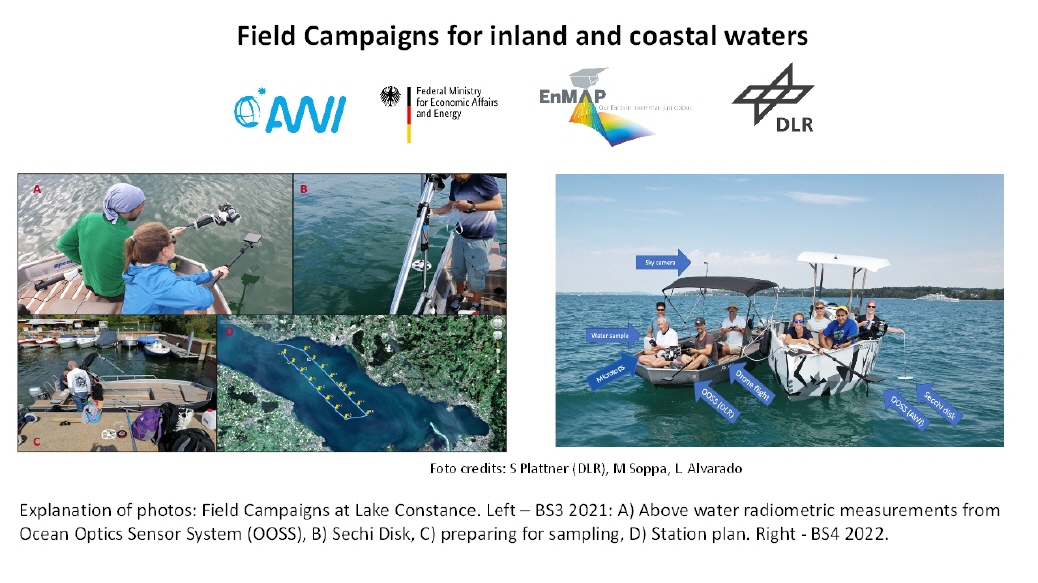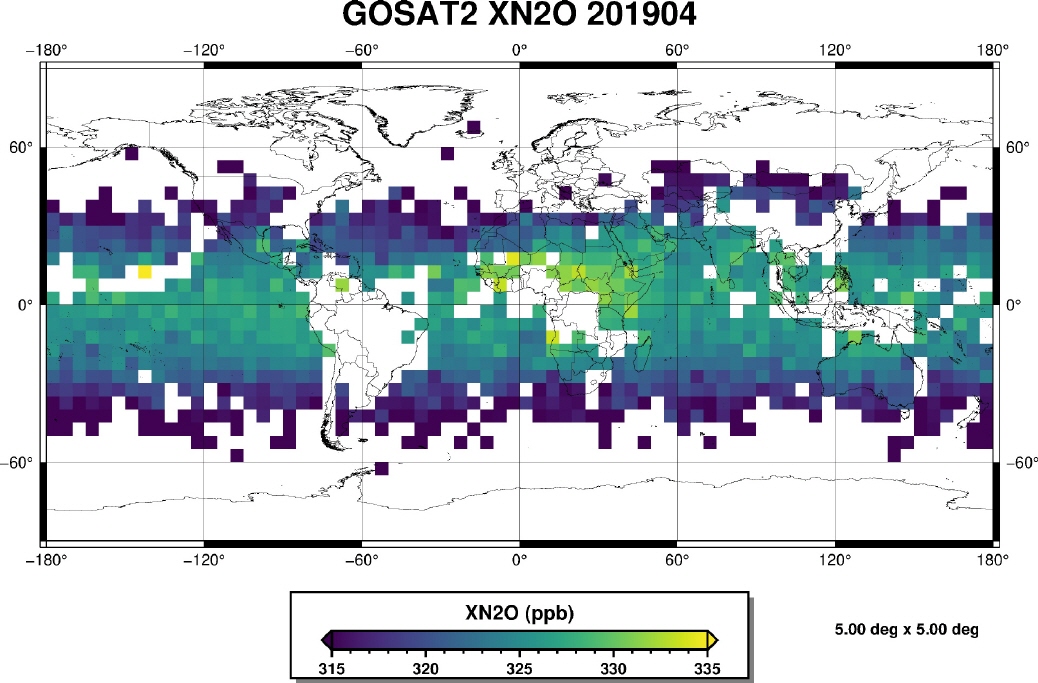Bild des Monats
April 2024:
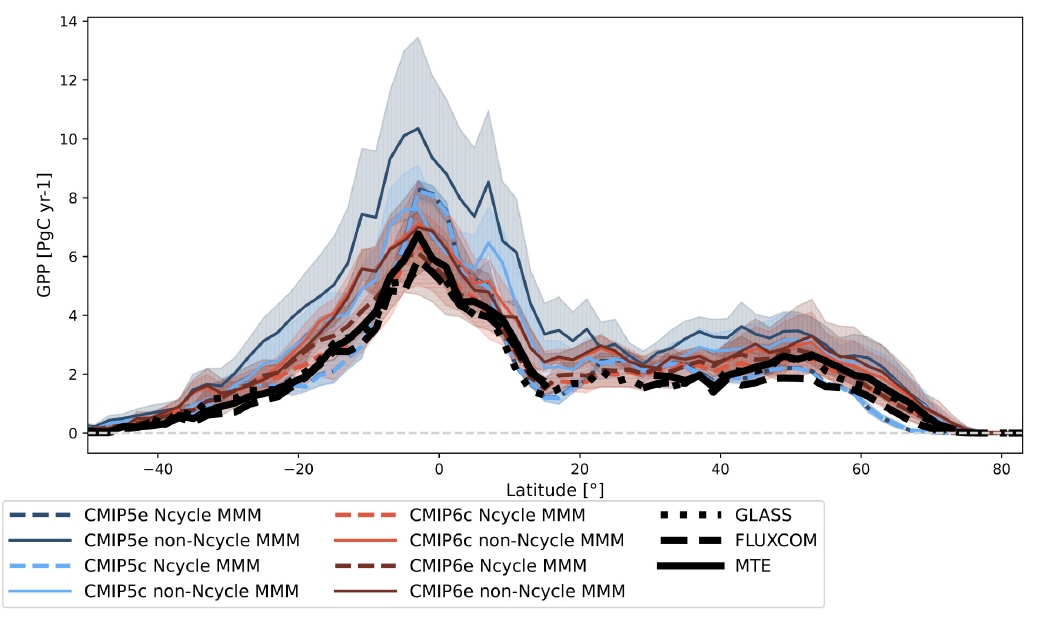
Our figure of the month shows the gross primary production (GPP) from Coupled Model Intercomparison Project Phase 6 (CMIP6; red; Eyring et al., 2016) and CMIP5 (blue) models with (dashed) and without (solid) interactive nitrogen cycle (Ncycle) compared to reference data sets based on measurements of the FLUXNET eddy covariance tower network: a data set upscaled with the model tree ensembles (MTE) approach and FLUXCOM data, which additionally incorporate Moderate Resolution Imaging Spectroradiometer (MODIS) as well as meteorological data using various machine learning methods. Furthermore, both simulations with prescribed CO2emissions (e, darker colors) and prescribed concentrations (c, lighter colors) are used. GPP represents the CO2 uptake on land due to photosynthesis. This was one of the biggest weaknesses of the CMIP5 ensemble, with most models overestimating photosynthesis. In the figure, this can be seen by the large overestimation of non-Ncycle CMIP5 compared to the reference data sets. The CMIP6 non-Ncycle MMMs show a much better approximation across all latitudes, with a slight reduction of the bias in the NH but a significant overestimation in the tropics. The CMIP6 Ncycle models show a very good agreement with the reference data across all latitudes, now with slight underestimations at high latitudes.
This figure is part of Gier et al (2024), which investigates carbon cycle variables in CMIP6 and CMIP5 simulations and is currently under discussion for Biogeosciences. Gier et al. (2024) concludes, that there is a significant improvement in the simulation of photosynthesis in models with nitrogen cycle, as well as only small differences between emission and concentration-based simulations. Thus, it recommends to use emission driven simulations in the upcoming CMIP7 simulations as default setup as well as to view the nitrogen cycle as a necessary part of all future carbon cycle models.
The study was supported by the Climate-Carbon Interactions in the Current Century (4C) project, which is funded by the EU under the Horizon 2020 program. The figure was made using the Earth System Model Evaluation Tool v2 (ESMValTool; Eyring et al., 2020). ESMValTool includes many diagnostics to use with CMIP models and observations, as well as common preprocessor functions, such as the computation of multi-model means, area averages, and the derivation of custom variables, which were used for this work.
Related projects:
Climate-Carbon Interactions in the Current Century (4C)
Coupled Model Intercomparison Project (CMIP)
REFERENCES
Eyring, V., Bony, S., Meehl, G. A., Senior, C. A., Stevens, B., Stouffer, R. J., and Taylor, K. E.: Overview of the Coupled Model Intercomparison Project Phase 6 (CMIP6) experimental design and organization, Geosci Model Dev, 9, 1937-1958, 10.5194/gmd-9-1937-2016, 2016.
Eyring, V., Bock, L., Lauer, A., Righi, M., Schlund, M., Andela, B., Arnone, E., Bellprat, O., Brötz, B., Caron, L. P., Carvalhais, N., Cionni, I., Cortesi, N., Crezee, B., Davin, E. L., Davini, P., Debeire, K., de Mora, L., Deser, C., Docquier, D., Earnshaw, P., Ehbrecht, C., Gier, B. K., Gonzalez-Reviriego, N., Goodman, P., Hagemann, S., Hardiman, S., Hassler, B., Hunter, A., Kadow, C., Kindermann, S., Koirala, S., Koldunov, N., Lejeune, Q., Lembo, V., Lovato, T., Lucarini, V., Massonnet, F., Müller, B., Pandde, A., Pérez-Zanón, N., Phillips, A., Predoi, V., Russell, J., Sellar, A., Serva, F., Stacke, T., Swaminathan, R., Torralba, V., Vegas-Regidor, J., von Hardenberg, J., Weigel, K., and Zimmermann, K.: Earth System Model Evaluation Tool (ESMValTool) v2.0 – an extended set of large-scale diagnostics for quasi-operational and comprehensive evaluation of Earth system models in CMIP, Geosci. Model Dev., 13, 3383-3438, 10.5194/gmd-13-3383-2020, 2020.
Gier, B. K., Schlund, M., Friedlingstein, P., Jones, C. D., Jones, C., Zaehle, S., and Eyring, V.: Representation of the Terrestrial Carbon Cycle in CMIP6, EGUsphere [preprint], https://doi.org/10.5194/egusphere-2024-277, 2024.
März 2024:
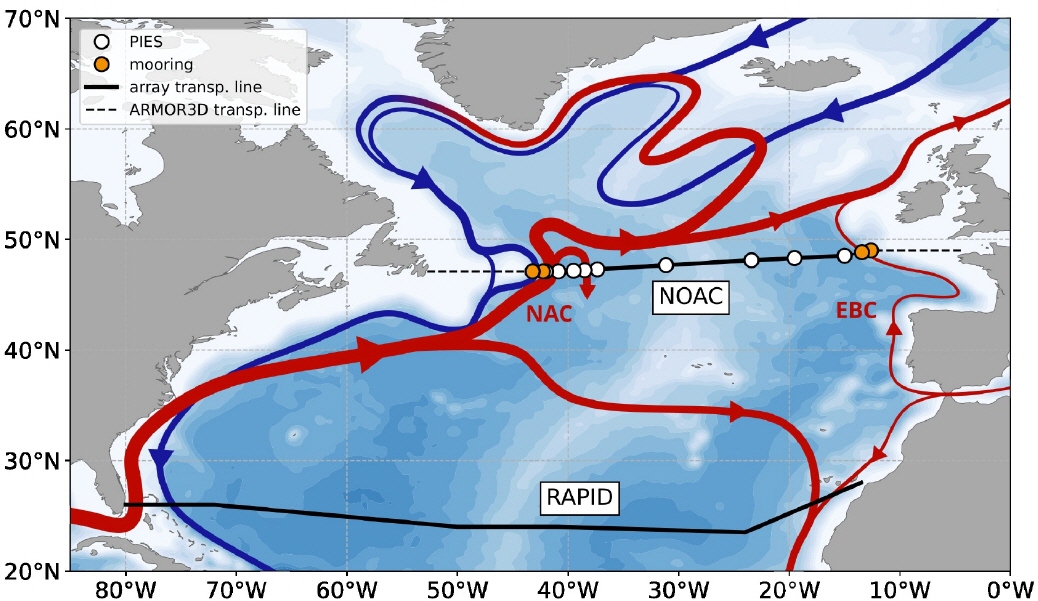
Since climate model studies project a decline of the Atlantic Meridional Overturning Circulation (AMOC) in the 21st century, monitoring AMOC changes remains essential. While AMOC variability is expected to be coherent across latitudes on longer than decadal timescales, connectivity on inter-annual and seasonal timescales is less clear. Model studies and observational estimates disagree on the regions and timescales of meridional connectivity and AMOC observations at multiple latitudes are needed to study its connectivity. We calculate basin-wide AMOC volume transports (1993-2018) from measurements of the North Atlantic Changes (NOAC) array at 47°N, combining data from moored instruments with hydrography and satellite altimetry. The mean NOAC AMOC is 17.2\,Sv exhibiting no long-term trend. Both the unfiltered and low-pass filtered NOAC AMOC show a significant correlation with the RAPID-MOCHA-WBTS AMOC at 26°N when the NOAC AMOC leads by about one year.
More information:
Wett, S., M. Rhein, D. Kieke, C. Mertens, und M. Moritz (2023), Meridional connectivity of a 25-year observational AMOC record at 47°N. Geophysical Research Letters, 50, e2023GL103284, doi:10.1029/2023GL103284.
Februar 2024:
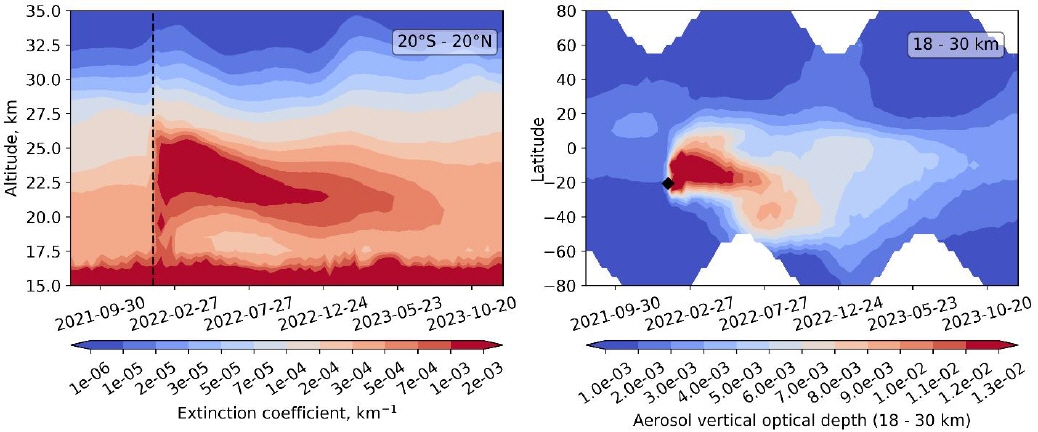
Vertical distributions of the stratospheric aerosol extinction coefficient were retrieved at the University of Bremen from measurements of scattered solar light in the limb viewing geometry made by the OMPS-LP instrument of NASA/NOAA. The obtained data enable us to investigate the evolution of the aerosol plume after the eruption of the Hunga Tonga–Hunga Haʻapai volcano in January 2022.
The left panel shows the zonal mean aerosol extinction coefficient distribution in tropics. The plume maximum reached the altitude of about 26 km and remained at these altitudes until the middle of May 2022. Thereafter, a rapid sinking of the plume maximum is observed. The right panel shows the vertical optical depth of the stratospheric aerosol (18 – 30 km). The plume mostly propagated to the southern hemisphere. Some transport events into the northern hemisphere are also seen, e.g. at the end of 2022. At the end of the analyzed record (December 2023), elevated values of the stratospheric aerosol optical depth are still observed in the tropics and southern mid-latitudes.
Dezember 2023:
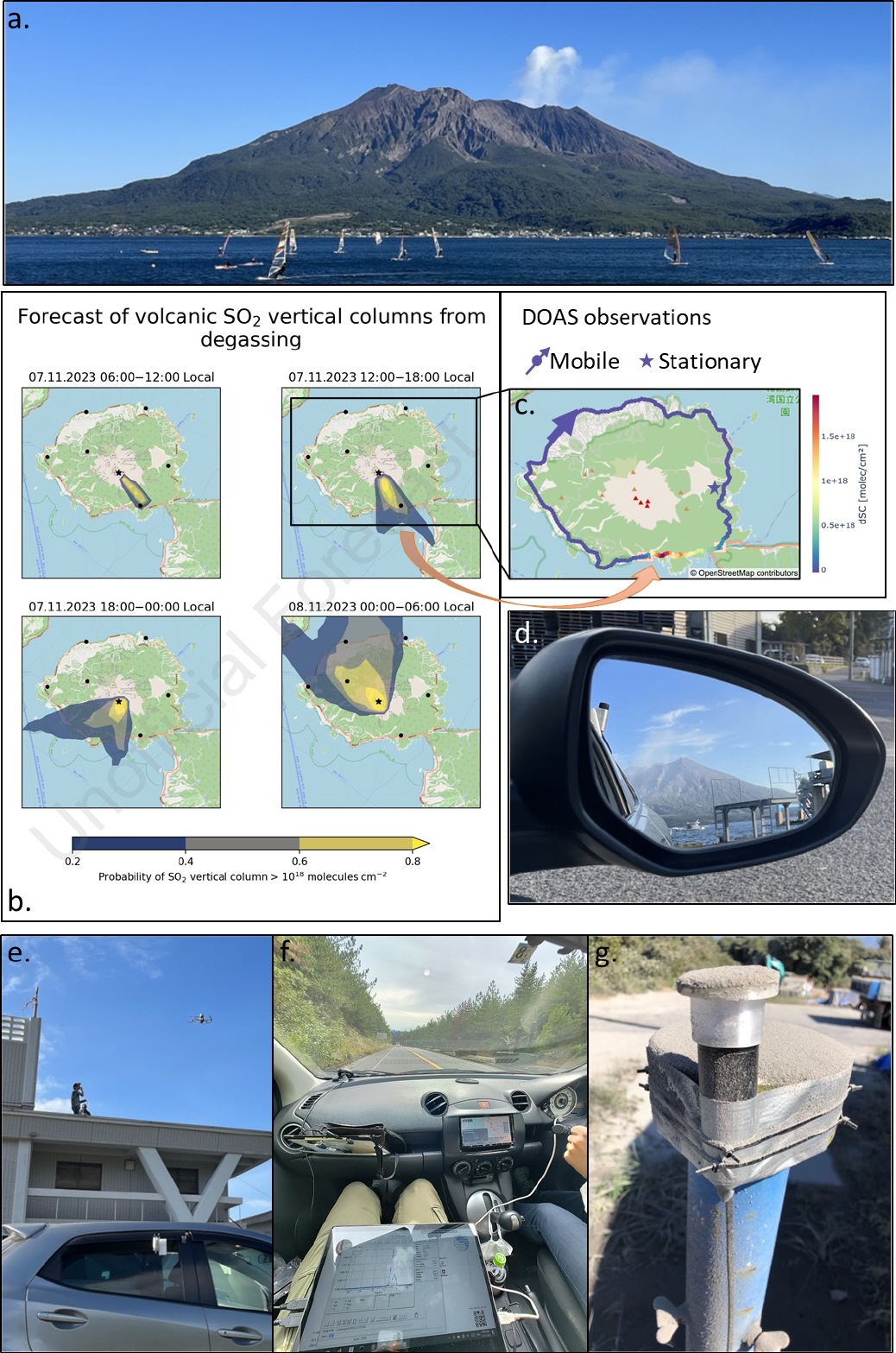
On the monitoring and modeling of volcanic emissions
Alexandros Panagiotis Poulidis 1, Simon Bittner 1, Andreas Richter 2 and Mihalis Vrekoussis 1,2,3
1 Institute of Environmental Physics (IUP-UB), University of Bremen, Bremen, Germany
2 Center of Marine Environmental Science (MARUM), University of Bremen, Germany
3 Climate and Atmosphere Research Center (CARE-C), The Cyprus Institute, Nicosia, Cyprus
VOLCOM campaign:
Due to the devastating potential of volcanoes, the scientific community tends to focus on the impacts of large-scale eruptions, leaving a gap in the study of the less spectacular, but equally important, non-explosive emissions from volcanoes. Measuring and modeling the outgassing of those emissions was the main objective of the Volcanic Emissions Observation and Modeling (VOLCOM) campaign – a pilot case study on observing near-constant "passive" volcanic emissions carried out by the LAMOS and DOAS groups at IUP between November 3-17, 2023. Our target was Sakurajima volcano in Japan, one of the most active volcanoes in the world (Fig. 1a).
For the observations, two DOAS devices were used; one for stationary and one for mobile measurements (Fig. 1d,f,g). Although the campaign focused on volcanic gas emissions, field work on an active volcano (even during periods of relative low activity) means that the probability of volcanic ash showers always needs to be considered (Fig. 1g)! The campaign had two specific objectives. First, to test the capabilities of an automated, adaptable forecasting suite designed by the LAMOS group (Fig. 1b) and second, to deploy and test in real conditions the performance of a new temperature stabilization device that allows for high-quality mobile-based-DOAS measurements (Fig. 1c,d).
During the campaign, real-time analysis of the mobile-DOAS observations (Fig. 1f), benefitted by the the negligible SO2 background, allowed us to carry out targeted measurements across and along the plume up to 50 km away from the source. Data gathered from the campaign will be used to improve our understanding of volcanic gas emissions from Sakurajima as well as their representation in chemical models.
Participants:
The campaign was carried out as an international collaboration between the IUP and Kyoto University (Japan), the University of Geneva (Switzerland), the University of Clermont Auvergne (France) and the National Research Institute for Earth Science and Disaster Prevention (Japan), allowing for different synergistic measurements (e.g. Fig. 1e).
Acknowledgments:
The VOLCOM campaign was supported by grants from the Japan Society for the Promotion of Science, the University of Bremen Impulse funding scheme and the Postgraduate International Programme in Physics and Electrical Engineering (PIP), and the Integrated Program for the Next Generation Volcano Research and Human Resource Management project, funded by the Japan Ministry of Education, Culture, Sports, Science and Technology. The forecasts were performed on the HPC cluster Aether at the University of Bremen, financed by DFG within the scope of the Excellence Initiative.
November 2023:

During Polar spring, measurements often report very low ozone concentrations near the surface. These well-known ozone depletion events are the result of halogen-catalysed ozone removal. The halogens originate from seawater and are transferred to the atmosphere via the cryosphere from brine-covered ice, frost flowers or snow. While this is a natural phenomenon, it is linked to anthropogenic mercury pollution, as bromine compounds also transfer gaseous mercury into its particulate form. The latter is deposited on snow and ice and can then be transferred into the ocean ecosystem.
While the photochemistry leading to ozone depletion is rapid and local, the conditions for ozone depletion events are often influenced by large-scale meteorology. This was studied in detail in a recent publication by Zilker et al. [2023] for the Arctic station at Ny-Ålesund. When comparing the meteorological conditions in the Arctic region during days with and without low ozone observations in Ny-Ålesund, clear patterns emerged. As expected, satellite-observed tropospheric BrO columns are higher during low ozone events in the area around Ny-Ålesund and a large area up to Greenland. Similarly, lower temperatures are found around Ny-Ålesund on these days, as well as a pronounced negative anomaly in surface pressure East of Spitsbergen. The combination of the low pressure over the Barents Sea and anomalously high pressure in the region of the Icelandic Low leads to a blocking situation, bringing cold Polar air to Ny-Alesund.
With temperatures in the Arctic rising much faster than in other regions of the world, significant changes in Arctic meteorology and, thereby, Polar ozone depletion events are expected in the future, with hard-to-predict effects on the photochemistry in the Arctic boundary layer air.
Zilker, B., Richter, A., Blechschmidt, A.-M., von der Gathen, P., Bougoudis, I., Seo, S., Bösch, T., and Burrows, J. P.: Investigation of meteorological conditions and BrO during ozone depletion events in Ny-Ålesund between 2010 and 2021, Atmos. Chem. Phys., 23, 9787–9814, https://doi.org/10.5194/acp-23-9787-2023, 2023.
Oktober 2023:
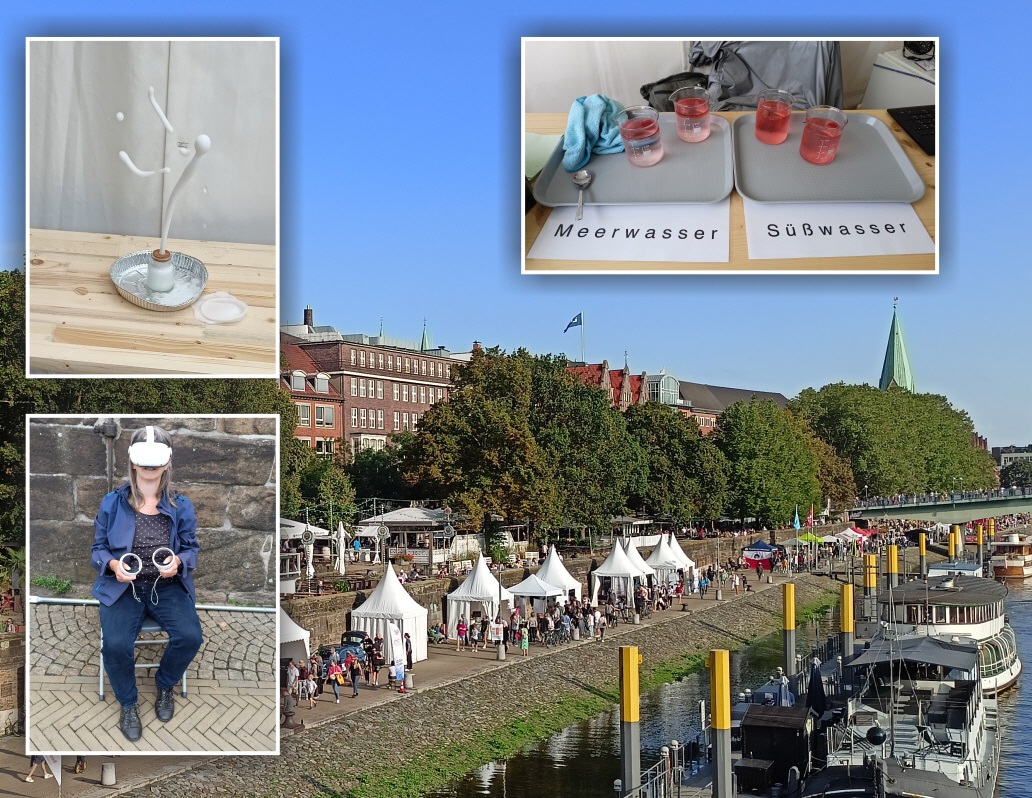
Feuer und Eis: Das IUP bei der Forschungsmeile 2023
Auch in diesem Jahr nahm das IUP an der Forschungsmeile im Rahmen der Maritimen Woche teil. Am 16. Und 17. September 2023 wurden an der Weserpromenade „Schlachte“ unterschiedliche Forschungsbereiche der Öffentlichkeit präsentiert. Mit dabei war auch wieder das „Eiswürfelexperiment“ zur Beantwortung der Frage: Wo schmilzt ein Eiswürfel schneller, in Süßwasser oder Meerwasser? Außerdem konnten kleine und große Besucher*innen sich auch über den Einfluss von Vulkanen auf das Klima informieren und sogar einen kleinen „Vulkan“ ausbrechen lassen. Ein Ausflug in die virtuelle Realität mit Bildern von einer Polarstern-Expedition ins Eismeer war auch möglich.
Kontakt: Stefan Noël (stefan.noel@iup.physik.uni-bremen.de)
Field Campaigns for inland and coastal waters
The picture shows the AWI and DLR teams during the field campaigns at Lake Constance in 2020 and, more recently, in 2022. Several measurements were made synchronously with the satellite acquisitions including above water reflectance, total suspended matters and absorption of phytoplankton and coloured dissolved organic matter. These data are used to validate Level 2 and Level 3 ocean colour products from hyperspectral and multispectral satellite sensors and to develop bio-optical algorithms to retrieve various optical water constituents (dissolved organic matter, phytoplankton groups and other particles). The image on the right shows the set of measurements taken during the EnMAP validation campaign. The German environmental satellite EnMAP was successfully launched on 1 April 2022. Over the next few years, the hyperspectral mission will take images of the Earth's surface in about 250 colours ("spectral bands"), providing more detailed information about inland and coastal waters than ever before.
For more information, see https://www.enmap.org/ and the publications of the Phytooptics group at https://www.awi.de/index.php?id=2556&L=1.
Contact:
Dr Mariana A. Soppa (msoppa@awi.de)
Prof. Dr. Astrid Bracher (abracher@awi.de)
Juli 2023:
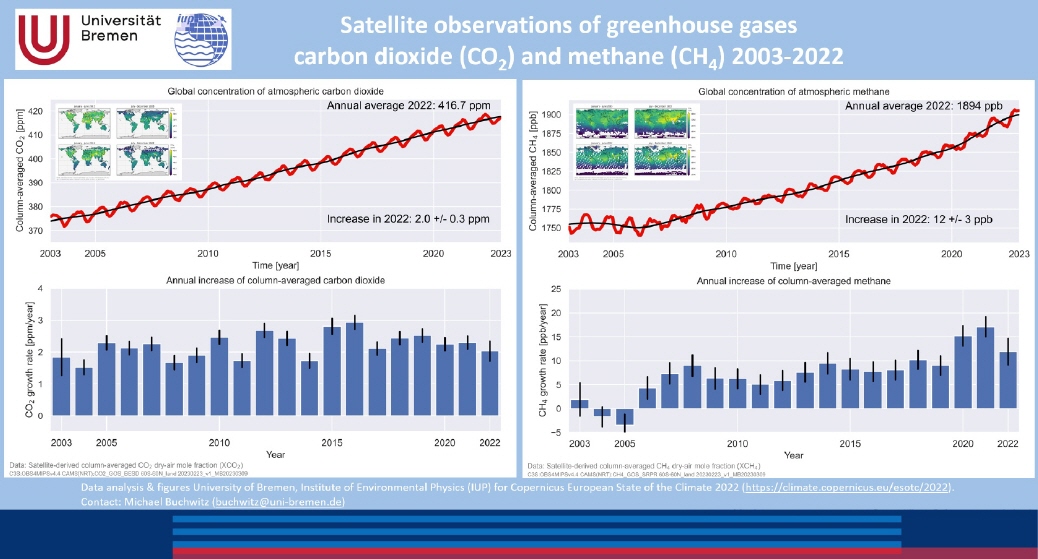
Treibhausgase CO2 und Methan steigen weiter an
Kohlenstoffdioxid (CO2) und Methan (CH4) sind wichtige Treibhausgase und steigende atmosphärische Konzentrationen führen zu Erderwärmung.
Das IUP der Universität Bremen entwickelt Methoden, um die atmosphärischen Verteilungen dieser beiden wichtigen Gase vom Weltraum aus zu messen [1] und zu interpretieren [2].
Das IUP stellt diese Daten kostenlos für alle interessierten Nutzer zur Verfügung, und zwar entweder über IUP-Webseiten (siehe https://www.iup.uni-bremen.de/carbon_ghg/ und dortige Links) oder über Dritte (z.B. ESA (https://climate.esa.int/en/projects/ghgs/) oder Copernicus Klimawandelservice [3] [4]).
Leider zeigen die Zeitreihen beide Gase derzeit nur einen Trend, nämlich nach oben, siehe Abbildung. Der Grund sind steigende Emissionen wobei für Methan auch eine Abnahme des chemischen Methanabbaus in der Atmosphäre einen Beitrag liefert, zu mindestens in einigen Jahren. Der Hauptgrund für steigende CO2-Konzentrationen liegt in der Verbrennung fossiler Brennstoffe (Öl, Kohle, Erdgas). Bei Methan spielen auch natürliche Quellen wie Sümpfe eine wichtige Rolle.
Weitere Erläuterungen und Details zu dieser Thematik und was uns diese Satellitendaten zeigen siehe das aktuelle „European State of the Climate“ Assessment [5].
Referenzen:
[1] Reuter, M., Buchwitz, M., Schneising, O., Noel, S., Bovensmann, H., Burrows, J. P., Boesch, H., Di Noia, A., Anand, J., Parker, R. J., Somkuti, P., Wu, L., Hasekamp, O. P., Aben, I., Kuze, A., Suto, H., Shiomi, K., Yoshida, Y., Morino, I., Crisp, D., O'Dell, C. W., Notholt, J., Petri, C., Warneke, T., Velazco, V. A., Deutscher, N. M., Griffith, D. W. T., Kivi, R., Pollard, D. F., Hase, F., Sussmann, R., Te, Y. V., Strong, K., Roche, S., Sha, M. K., De Maziere, M., Feist, D. G., Iraci, L. T., Roehl, C. M., Retscher, C., and Schepers, D.: Ensemble-based satellite-derived carbon dioxide and methane column-averaged dry-air mole fraction data sets (2003-2018) for carbon and climate applications, Atmos. Meas. Tech., 13, 789-819, https://doi.org/10.5194/amt-13-789-2020, 2020.
[2] Buchwitz, M., Reuter, M., Schneising, O., Noel, S., Gier, B., Bovensmann, H., Burrows, J. P., Boesch, H., Anand, J., Parker, R. J., Somkuti, P., Detmers, R. G., Hasekamp, O. P., Aben, I., Butz, A., Kuze, A., Suto, H., Yoshida, Y., Crisp, D., and O'Dell, C., Computation and analysis of atmospheric carbon dioxide annual mean growth rates from satellite observations during 2003-2016, Atmos. Chem. Phys., 18, 17355-17370, https://doi.org/10.5194/acp-18-17355-2018, 2018.
[3] https://cds.climate.copernicus.eu/cdsapp#!/dataset/satellite-carbon-dioxide?tab=overview
[4] https://cds.climate.copernicus.eu/cdsapp#!/dataset/satellite-methane?tab=overview
[5] https://climate.copernicus.eu/climate-indicators/greenhouse-gas-concentrations
Juni 2023:
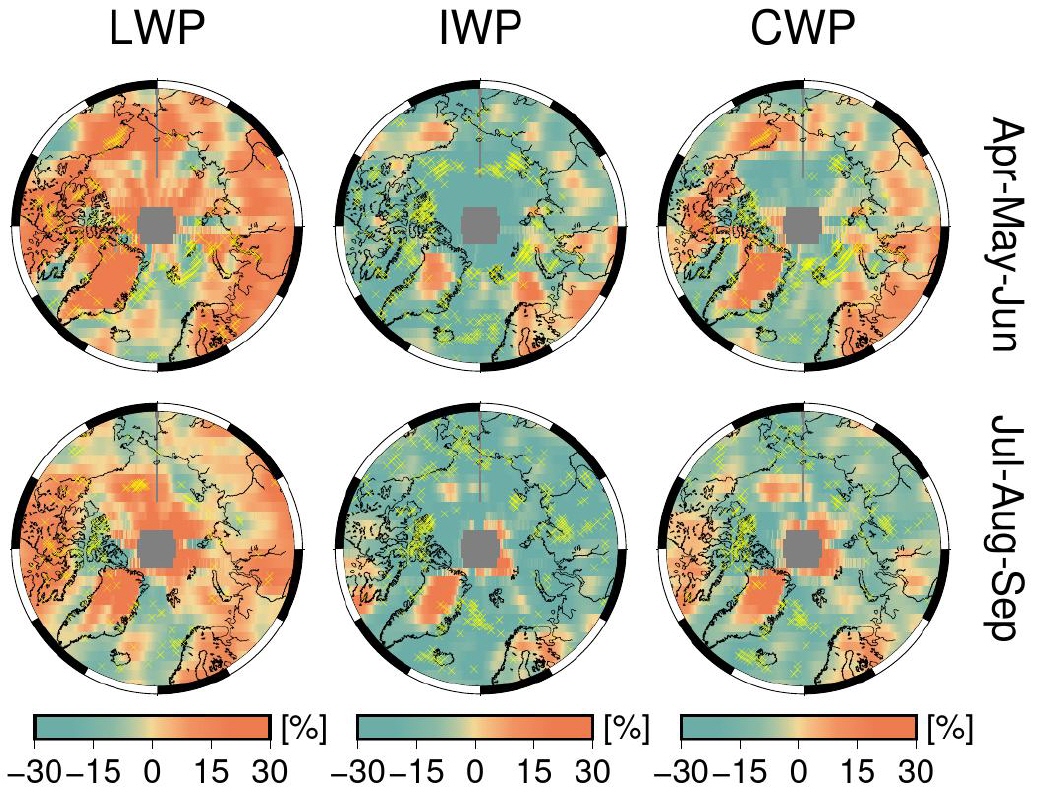
Arktische Wolken sind ein wichtiger Faktor in der Beeinflussung des arktischen Klimas. Sie wirken dabei sowohl erwärmend als auch abkühlend. Die Gründe wann sie erwärmend oder abkühlend wirken hängen von verschiedenen Faktoren ab. Hierzu gehören u.a. auch die thermodynamische Phase der Wolken (also bis zu welchem Grad sie flüssig oder gefrorenes Wasser beinhalten). Im Rahmen einer aktuellen Studie hat die Aerosol & Wolkengruppe des IUP/Ubremen systematisch Satellitendaten der Wolkenphase analysiert.
Einige Wolkeneigenschaften haben sich in den letzten drei Dekaden deutlich geändert. So hat der z.B. der Flüssigwasserpfad (eng. Liquid Water Path, LWP) in den meisten Regionen der Arktis zugenommen. Im ähnlichen Umfang wie der LWP zugenommen hat, hat der Eiswasserpfad (engl. Ice Water Path, IWP) abgenommen. Das hat wesentliche Konsequenzen für den Strahlungshaushalt in der Arktis.
Reference:
Lelli, L., Vountas, M., Khosravi, N., and Burrows, J. P.: Satellite remote sensing of regional and seasonal Arctic cooling showing a multi-decadal trend towards brighter and more liquid clouds, Atmos. Chem. Phys., 23, 2579–2611, https://doi.org/10.5194/acp-23-2579-2023, 2023.
Kontakt/contact: Marco Vountas vountas@iup.physik.uni-bremen.de
https://www.iup.uni-bremen.de/aerosol
April 2023:
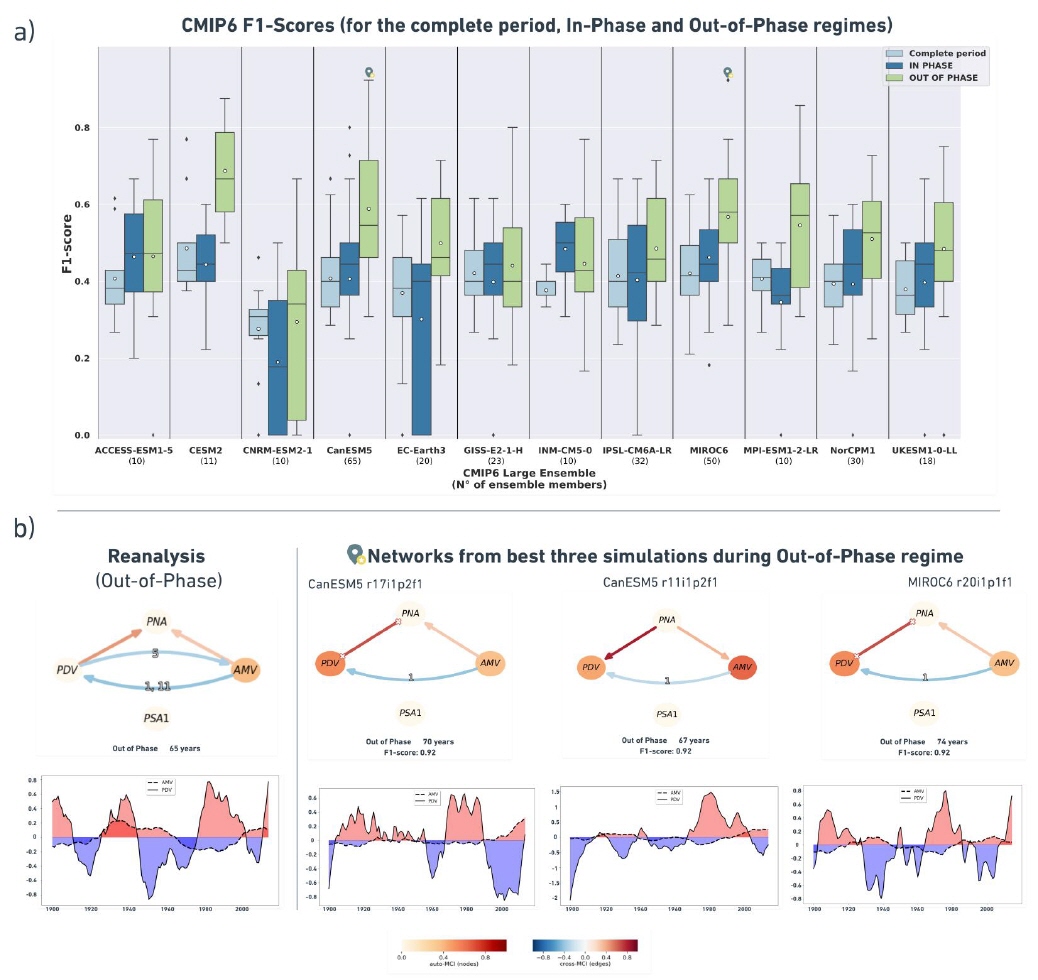
Regime-oriented causal analysis of Atlantic-Pacific teleconnections in CMIP6
Modes of natural climate variability from interannual to multidecadal timescales have large effects on regional and global climate with important socio-economic impacts (Eyring et al., 2021). Despite their importance, systematic evaluation of climate models and their simulation of internal variability remains a challenging task (Eyring et al., 2019). Here, causal discovery provides a way to estimate dynamical climate dependencies from timeseries data. In Karmouche et al. (2022), we perform a regime-oriented causal model evaluation to assess the ability of models participating in the Coupled Model Intercomparison Project Phase 6 (CMIP6, Eyring et al., 2016) to represent the observed changing interactions between the Pacific Decadal Variability (PDV) and the Atlantic Multidecadal Variability (AMV) and their extra-tropical teleconnections to the Pacific North- and Pacific South- American Patterns (PNA and PSA1). The indices for these modes of climate variability are calculated by the Climate Variability Diagnostic Package for Large Ensembles (CVDP-LE, Phillips et al., 2020).
Our figure of the month shows a comparison of causal networks for reanalysis datasets (ERSSTv5 for PDV and AMV, ERA20C_ERA5 for PNA and PSA1) and CMIP6 Large Ensemble (LE) historical simulations during the period 1900-2014. The interactions between the aforementioned modes of climate variability are hypothesized to follow different regimes depending on the physical state of the Atlantic or Pacific (i.e. AMV or PDV phase). To identify phase-dependent sets of connections (causal networks), we perform the analysis on shorter periods (regimes) that represent different phases based on the low-pass filtered AMV and PDV indices, thus identifying the regime-oriented analysis. Here, we refer to the time periods where AMV and PDV are on the same phase (both positive or both negative) by “In-Phase regime”, whereas for the periods where the two indices are on opposite phases (one negative while the other is positive) we use the term “Out-of-Phase regime”.
We run the PCMCI+ (Runge et al., 2019; Runge, 2020) causal discovery method, available as part of the Tigramite package, to estimate causal networks from CMIP6 Large Ensemble models and compare results to those from reanalysis data during different specified periods. Blue links in the resulting causal graphs translate an opposite-sign response while red links a same-sign response. The labels on the links, when shown, denote the time-delay of the response in years. The figure shows (a) a whisker plot for the distribution of F1-scores, a measure of similarity between causal networks following methods from Nowack et al. (2020), across the CMIP6 LEs during the complete period, In-Phase regime, and Out-of-Phase regime with light blue, dark blue, and green colored boxes, respectively. The white scatter points indicate that on average, CESM2, CanESM5, MIROC6, and MPI-ESM1-2-LR LEs exhibit better network similarity with observations during the Out-of-Phase regime. CanESM5 and MIROC6 LEs have the highest scores (0.92) during this regime, as indicated by the location markers on the whisker plot. In (b) we compare the causal graphs (three panels on the right) of these top-scoring realizations and their low-pass filtered AMV and PDV time series to those generated from reference reanalysis datasets (left). The networks in (b) agree on the 1-year lagged AMV→PDV link, illustrating an opposite-sign response. The positive contemporaneous PDV—PNA link is directed differently in CanESM5 r11i1p2f1 compared to reanalysis, and remains unoriented in CanESM5 r17i1p2f1 and MIROC6 r20i1p1f1. The Out-of-Phase graphs of these realizations also demonstrate an agreement on a same-sign contemporaneous AMV—PNA connection, which is weaker (lower cross-MCI value) than the PDV—PNA link. Overall, the regime-oriented causal model evaluation followed in Karmouche et al. (2022) has the potential of a powerful methodology that can be applied in a number of environment-related topics, offering tremendous insight to improve the understanding of the complex earth system and the state-of-the-art of climate modeling.
REFERENCES:
Eyring, V., Bony, S., Meehl, G. A., Senior, C. A., Stevens, B., Stouffer, R. J., and Taylor, K. E.: Overview of the Coupled Model Intercomparison Project Phase 6 (CMIP6) experimental design and organization, Geoscientific Model Development, 9, 1937–1958, 2016.
Eyring, V., Cox, P. M., Flato, G. M., Gleckler, P. J., Abramowitz, G., Caldwell, P., Collins, W. D., Gier, B. K., Hall, A. D., Hoffman, F. M., et al.: Taking climate model evaluation to the next level, Nature Climate Change, 9, 102–110, 2019
Eyring, V., Gillett, N., Achutarao, K., Barimalala, R., Barreiro Parrillo, M., Bellouin, N., Cassou, C., Durack, P., Kosaka, Y., McGregor, S., et al.: Human Influence on the Climate System: Contribution of Working Group I to the Sixth Assessment Report of the Intergovernmental Panel on Climate Change, IPCC Sixth Assessment Report, 2021
Karmouche, S., Galytska, E., Runge, J., Meehl, G. A., Phillips, A. S., Weigel, K., and Eyring, V.: Regime-oriented causal model evaluation of Atlantic-Pacific teleconnections in CMIP6, EGUsphere [preprint], https://doi.org/10.5194/egusphere-2022-1013, 2022.
Nowack, P., Runge, J., Eyring, V., and Haigh, J. D.: Causal networks for climate model evaluation and constrained projections, Nature communications, 11, 1–11, 2020.
Phillips, A. S., Deser, C., Fasullo, J., Schneider, D., and Simpson, I.: Assessing Climate Variability and Change in Model Large Ensembles: A User’s Guide to the “Climate Variability Diagnostics Package for Large Ensembles”, version 1, version, 1, 0, 2020
Runge, J.: Discovering contemporaneous and lagged causal relations in autocorrelated nonlinear time series datasets, in: Conference on Uncertainty in Artificial Intelligence, pp. 1388–1397, PMLR, 2020.
Runge, J., Nowack, P., Kretschmer, M., Flaxman, S., and Sejdinovic, D.: Detecting and quantifying causal associations in large nonlinear time series datasets, Science advances, 5, eaau4996, 2019
März 2023:
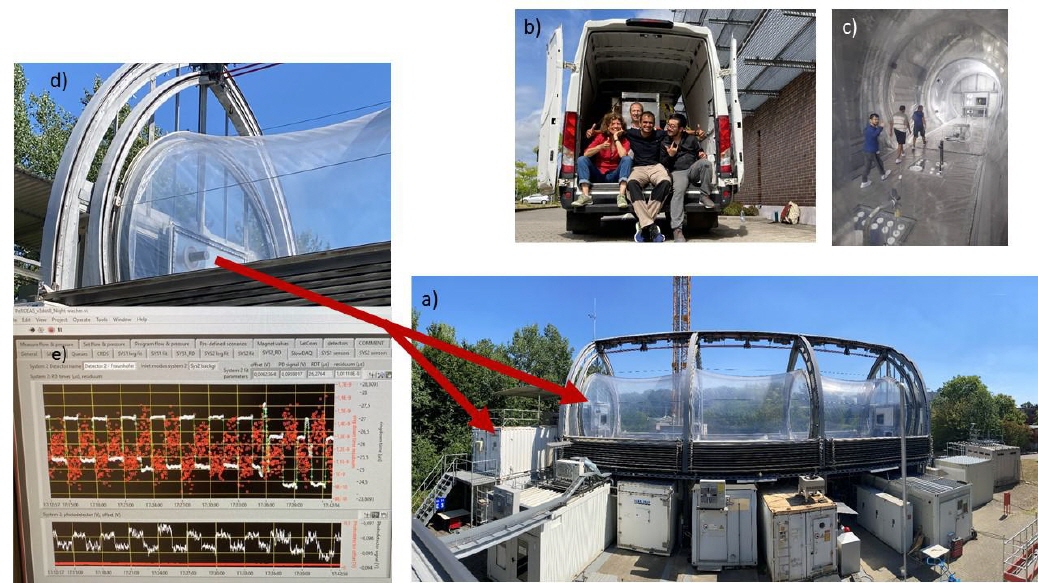
Workshop on the ROxCOMP22 campaign
Radical chemistry is of great importance for understanding the atmospheric chemical processing and formation of secondary pollutants. The TROLAS (Tropospheric Radical Observations and Laser Absorption Spectroscopy) group at the Institute of Environmental Physics has wide experience in the investigation of the distribution of peroxy radicals and their precursors, observed within airborne and ground based field measurements in different environments.
Scientists from IUP-TROLAS successfully participated with the airborne PeRCEAS
(Peroxy Radical Chemical Enhancement and Absorption Spectrometer) instrument in the 1-month long international comparison study ROxCOMP22. ROxCOMP22 aimed at improving the quality of the peroxy radical detection by bringing together instruments using different techniques to measure organic peroxy radicals worldwide. The 16 chamber experiments made in August 2022 in the SAPHIR chamber at the Forschungszentrum Jülich provided a unique opportunity to identify potential interferences or systematic errors while investigating relevant radical reactions under controlled chemical conditions.
After a calibration phase in the home laboratories, the first workshop on the discussion of the obtained ROxCOMP22 data has taken place In February 2023. The data analysis is still on-going.
Contact: Lola Andrés Hernández lola@iup.physik.uni-bremen.de
Februar 2023:
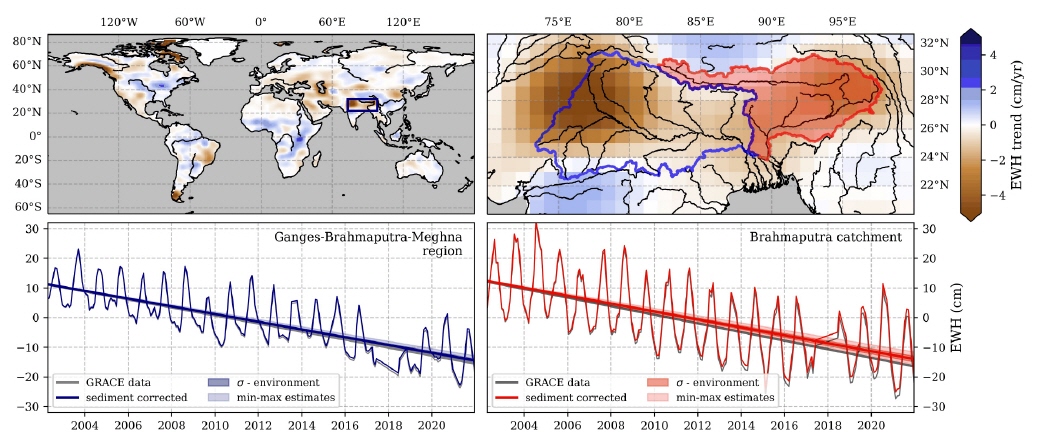
Gravity fields measured by geodetic satellites yield information on global mass variations and have proven crucial to monitor changes in water storage and fluxes. Thus, satellite gravimetry is a key component in the investigation of the massive groundwater depletion observed on the Indian subcontinent. In a current study, we look into the impact of river sediment transport on terrestrial EWH data measured by satellites of the Gravity recovery and Climate Experiment (GRACE) and its follow-on mission (GRACE-FO). While the mass loss by sediment transport in rivers is assumed to be below the detection limit of those satellites, it potentially impacts long term EWH trends derived from their data. The Indian subcontinent is drained by the Ganges and Brahmaputra rivers which constitute one of the the world's most sediment rich river systems. In this month's figure, we show the impact of sediment mass loss within the Ganges and Brahmaputra catchments on gravimetric estimates of EWH trends. Forthe whole Ganges-Brahmaputra-Meghna region, sediment transport accounts for roughly 4% of the gravity decrease currently attributed to groundwater depletion. Since most sediment is eroded from mountain regions, the impact of sediment transport on EWH trends in these regions is high (average of 14%).
Contact: Alexandra Klemme (aklemme@uni-bremen.de)
References:
Boergens, Eva; Dobslaw, Henryk; Dill, Robert (2020): COST-G GravIS RL01 Continental Water Storage Anomalies. V. 0004. GFZ Data Services. https://doi.org/10.5880/COST-G.GRAVIS_01_L3_TWS
Januar 2023:
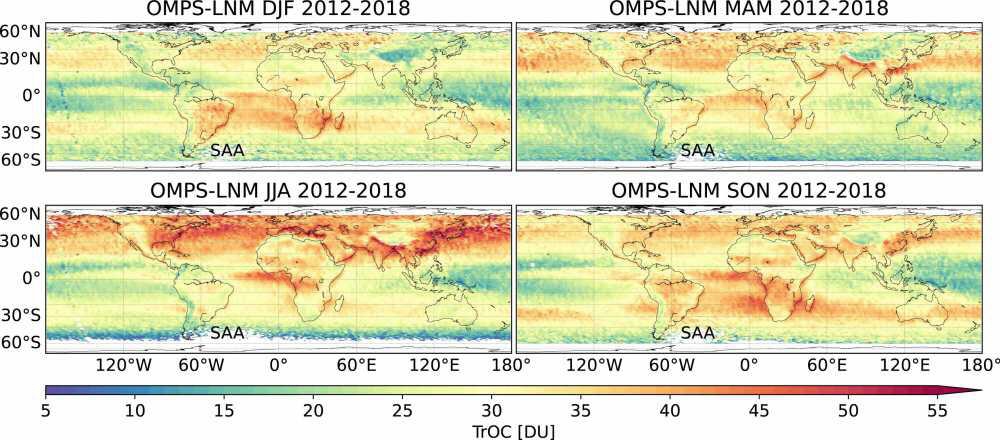
The SUOMI-NPP platform carries three instruments that measure ozone in limb and nadir viewing geometries. The OMPS-Nadir Napper (NM) provides total column ozone from the ground to the upper atmosphere. From spectral data of the OMPS-Limb profiler (LP), vertical ozone profiles are derived. Using the ozone data from both instruments, the tropospheric ozone column (from the ground to the tropopause, located between 7 and 17 km altitude, dependent on latitude) is calculated by subtracting the stratospheric column from the total. The figure shows the global seasonal mean of tropospheric ozone from 2012 to 2018 as observed by OMPS. The seasonal maps show the variable outflow of tropospheric ozone e.g. from Africa (biomass-burning regions), North-East America, and Eastern Asia (both industrial regions), where ozone is produced from chemical precursors, which are mainly air pollutants.
In addition to the OMPS tropospheric ozone algorithm, we used our advanced algorithms to retrieve the total column and profiles of ozone from both OMPS instruments. Similar algorithms have been applied to SCIAMACHY satellite data (2002-2012). In the next step, we will combine LMN tropospheric ozone data from SCIAMACHY and OMPS to obtain a long-term data record spanning at least 16 years for investigating changes in decadal timescales.
References
Arosio, C., Rozanov, A., Malinina, E., Eichmann, K.-U., von Clarmann, T., and Burrows, J. P.: Retrieval of ozone profiles from OMPS limb scattering observations, Atmos. Meas. Tech., 11, 2135–2149, https://doi.org/10.5194/amt-11-2135-2018, 2018.
Ebojie, F., von Savigny, C., Ladstätter-Weißenmayer, A., Rozanov, A., Weber, M., Eichmann, K.-U., Bötel, S., Rahpoe, N., Bovensmann, H., and Burrows, J. P., Tropospheric column amount of ozone retrieved from SCIAMACHY limb–nadir-matching observations, Atmos. Meas. Tech., 7, 2073-2096, https://doi.org/10.5194/amt-7-2073-2014, 2014.
Ebojie, F., Burrows, J. P., Gebhardt, C., von Savigny, C., Rozanov, A., Weber, M., and Bovensmann, H.: Global and zonal tropospheric ozone variations from 2003–2011 as seen by SCIAMACHY, Atmos. Chem. Phys., 16, 417-436, https://doi.org/10.5194/acp-16-417-2016, 2016.
Orfanoz-Cheuquelaf, A., Rozanov, A., Weber, M., Arosio, C., Ladstätter-Weißenmayer, A., and Burrows, J.P.: Total ozone column from Ozone Mapping and Profiler Suite Nadir Mapper (OMPS-NM) measurements using the broadband weighting function fitting approach (WFFA), Atmos. Meas. Tech., 14, 5771–5789, https://doi.org/10.5194/amt-14-5771-2021, 2021.
Orfanoz-Cheuquelaf, A, Arosio, C., Rozanov, A., Weber, M., Ladstätter-Weißenmayer, A., and Burrows, J.P., Tropospheric ozone column dataset from OMPS-LP/OMPS-NM limb-nadir matching, manuscript in preparation, 2022.
Dezember 2022:
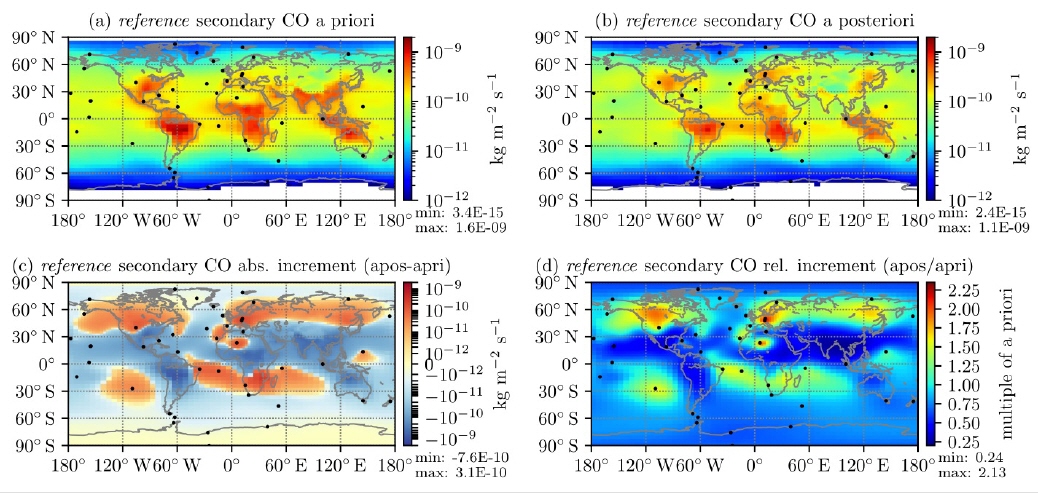
Johann Rasmus Nüß1, Nikos Daskalakis1, Fabian Günther Piwowarczyk1, Angelos Gkouvousis2,3, Oliver Schneising1, Michael Buchwitz1, Maria Kanakidou1,2,3, Maarten C. Krol4,5, Mihalis Vrekoussis1,6,7
1 Institute of Environmental Physics (IUP-UB), University of Bremen, Bremen, Germany
2 Environmental Chemical Processes Laboratory (ECPL), Department of Chemistry, University of Crete, Heraklion, Greece
3 Center for the Study of Air Quality and Climate Change (C-STACC), Institute of Chemical Engineering Sciences, Foundation for Research and Technology Hellas, Patras, Greece
4 Meteorology and Air Quality, Wageningen University and Research, Wageningen, the Netherlands
5 Institute for Marine and Atmospheric Research, Utrecht University, Utrecht, the Netherlands
6 Center of Marine Environmental Science (MARUM), University of Bremen, Germany
7 Climate and Atmosphere Research Center (CARE-C), The Cyprus Institute, Nicosia, Cyprus
Carbon monoxide (CO) in the atmosphere adversely affects air quality and climate, making knowledge about its sources crucial. However, current global bottom-up emission estimates retain significant uncertainties. We attempt to reduce these uncertainties by optimizing emission estimates for the second half of the year 2018 on a global scale with a focus on the Northern Hemisphere through the top-down approach of inverse modeling. Specifically, we introduce observations from the TROPOspheric Monitoring Instrument (TROPOMI) into the TM5-4DVAR model. The emissions are further constrained using NOAA surface flask measurements, with their locations denoted as black dots in the figures below.
Figure (a) shows the vertically integrated bottom-up estimate for the secondary, i.e. chemical, production of CO in the atmosphere for September 2018 as taken from the full-chemistry model TM5-MP. This production field is used as part of the initial emissions, the a priori, for our inversions. The resulting optimized field, the a posteriori, is shown in Figure (b). These emission fields lead to the smallest difference between the simulated mixing ratios and those observed by both TROPOMI and the NOAA flasks. Due to its strong dependence on photochemistry, secondary CO production rates vary by multiple orders of magnitude globally, making the absolute increments between a posteriori and a priori emissions hard to interpret (panel (c)). Therefore, we show their relative difference in Figure (d), i.e. the factor by which the emissions changed at each location.
Compared to the bottom-up estimates, we observe strong broad-scale emission reductions (up to 75 %) in China and India. In part, these reductions can be attributed to policy changes in China. However, the OH climatology we use to simulate chemical loss appears to be underestimated in that region, which skews the inversion towards lower emissions as well. Conversely, we find strong local emission increments over Europe and the Sahara. These are likely artifacts caused by the model’s limited capabilities to capture the surface flask measurements at these specific stations and cannot be confirmed by satellite observations.
Notably, the mixing ratios calculated using optimized emissions from the inversion driven solely by satellite observations agree very well with the flask measurements (comparison not shown). While this holds only south of 55° N, due to model limitations, it could potentially allow for near real-time inversions purely based on satellite observations. These would then be validated against and adjusted to the surface flasks as soon as they are available.
References:
Nüß, J. R., Daskalakis, N., Piwowarczyk, F. G., Gkouvousis, A., Schneising, O., Buchwitz, M., Kanakidou, M., Krol, M. C., Vrekoussis, M: Efficacy of high-resolution satellite observations in inverse modeling of carbon monoxide emissions, submitted to Journal of Advances in Modeling Earth Systems (JAMES), 2022
Contact: Rasmus Nüß (rasmus.nuess@uni-bremen.de)
November 2022:
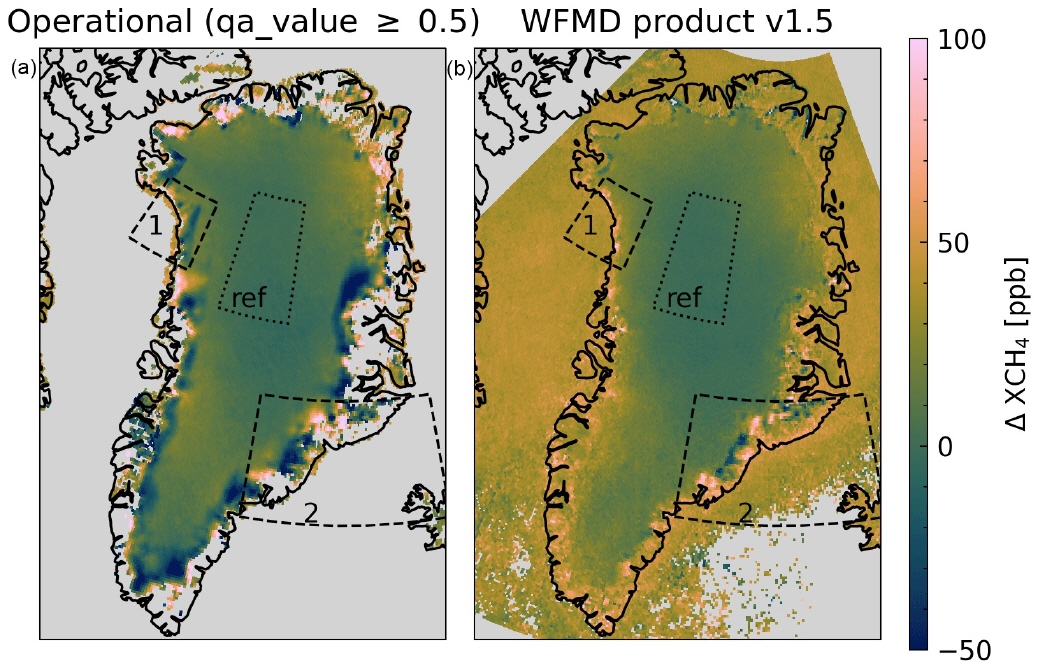
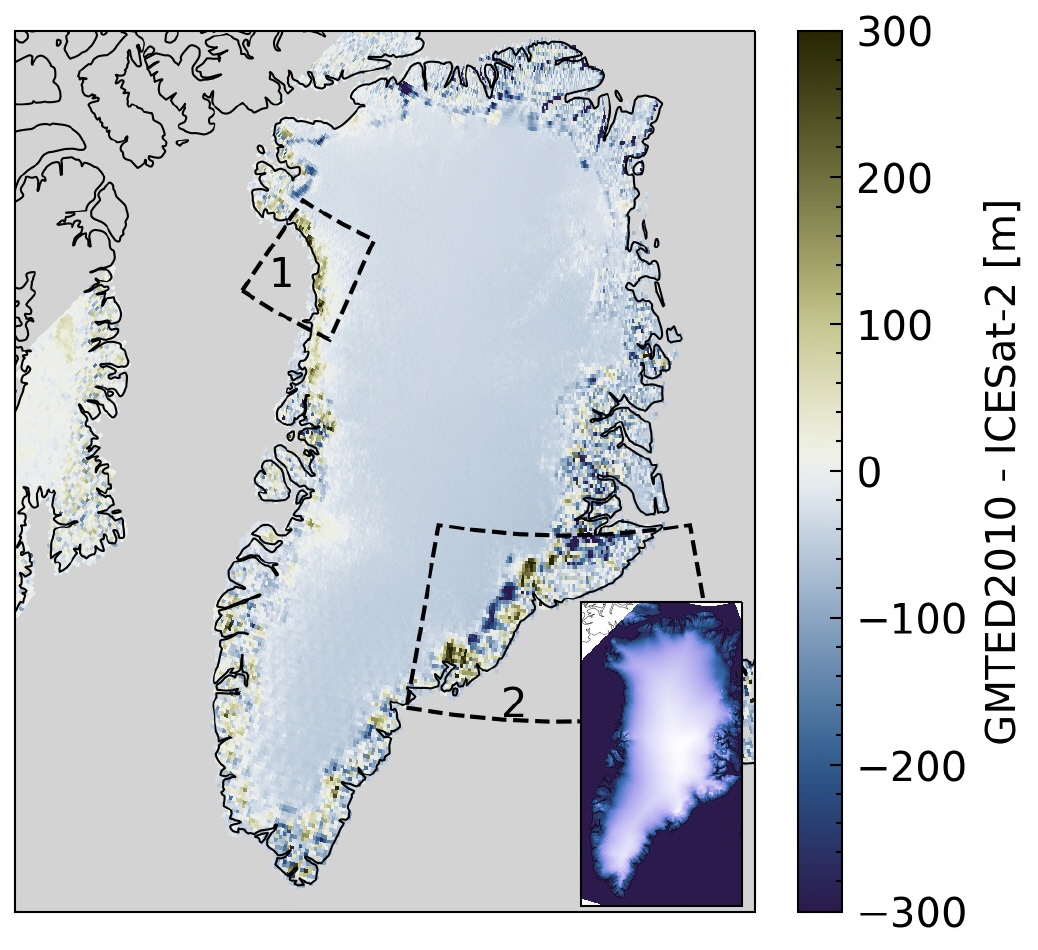
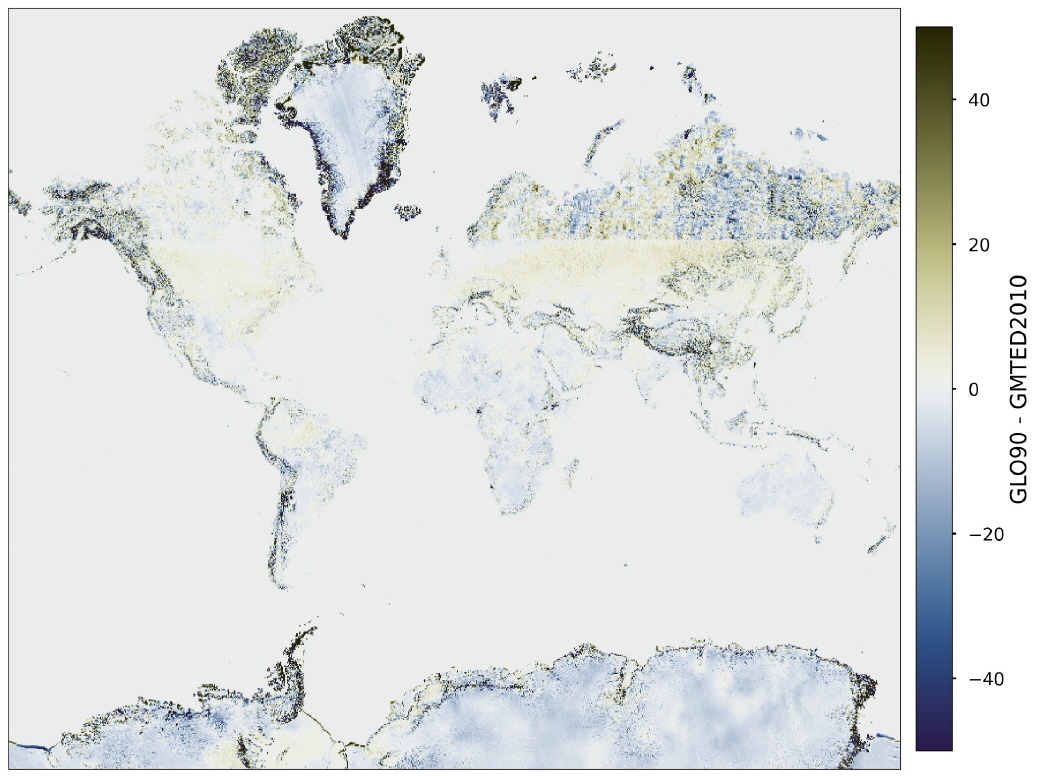
Methane anomalies in Greenland
Methane (CH4) represents the second most important greenhouse gas after carbon-dioxide (CO2) and is roughly 28-times more potent than CO2. It is released through human activities (agriculture, waste, fossil fuels,...) and natural processes, for example bio-chemical processes in wetlands or in thawing permafrost.
That is why we are investigating the atmospheric methane concentration (XCH4) within the framework of the junior-research group „Greenhouse gases in the Arctic“ using satellite data. Over Greenland strong methane anomalies could be observed (Fig. 1a), i.e. regions with very high or low concentrations. However these anomalies are not related to emissions from the permafrost but to inaccuracies in the digital elevation model (DEM) used in the calculations (Fig. 2), as our research has shown.
In addition to Greenland further regions show inaccuracies in older DEMs (Fig. 3). Following this finding a more recent DEM was implemented for the WFMD methane product which is developed at the IUP. The anomalies vanish in the new product both for Greenland (Fig 1b) and the other regions which improved the general quality of the product.
Reference:
Hachmeister, J., Schneising, O., Buchwitz, M., Lorente, A., Borsdorff, T., Burrows, J. P., Notholt, J., and Buschmann, M.: On the influence of underlying elevation data on Sentinel-5 Precursor TROPOMI satellite methane retrievals over Greenland, Atmos. Meas. Tech., 15, 4063–4074, https://doi.org/10.5194/amt-15-4063-2022, 2022.
Contact:
jonas_h@iup.physik.uni-bremen.de
Oktober 2022:
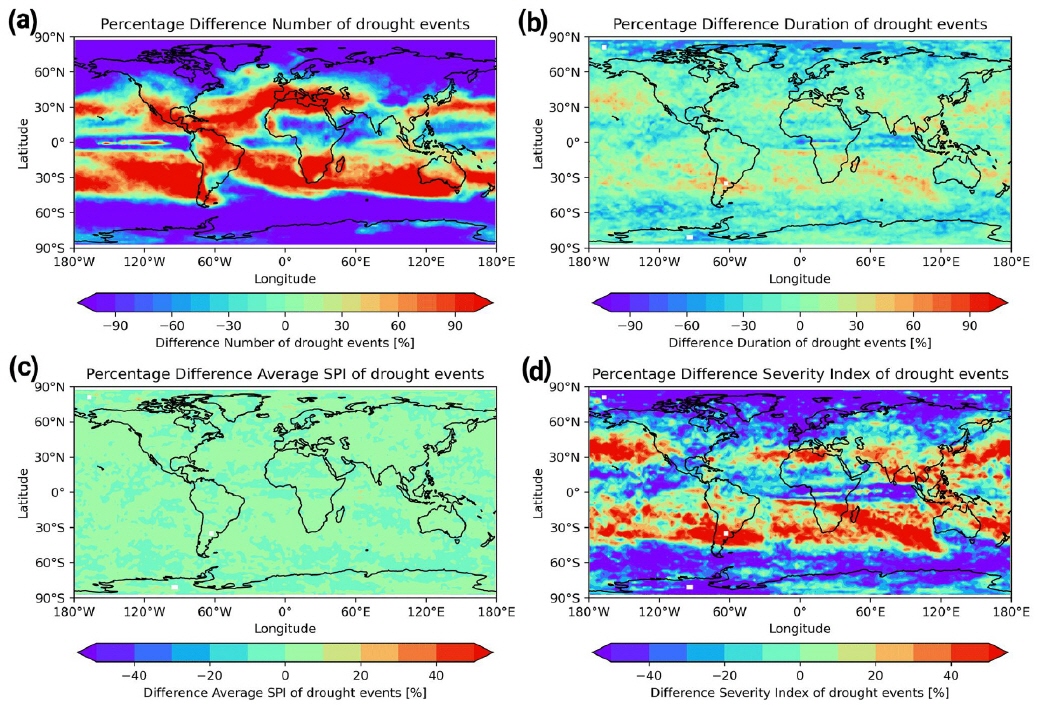
Zukünftige Veränderungen von Dürren im CMIP5-Ensemble, analysiert mit dem Earth System Model Evaluation Tool (ESMValTool)
Motiviert durch den trockenen Sommer dieses Jahres zeigt unser Bild des Monats zukünftige Veränderungen in Anzahl, Dauer, durchschnittlichem „standard precipitation index“ (SPI) und Schweregrad von Dürren, berechnet auf Grundlage des RCP8.5-Zukunftsszenario mit Klimamodellen des Coupled Model Intercomparison Project Phase 5 (CMIP5). Der SPI beschreibt lokale Niederschlagsanomalien und kann verwendet werden, um meteorologische Dürren zu identifizieren. Bis zum Ende des 21. Jahrhunderts zeigen die Projektionen eine Zunahme der Anzahl, Dauer und Schwere von Dürren vor allem in den schon heute trockenen, subtropischen Gebieten. Für Dürreindizes, die zusätzlich zum Niederschlag die potenzielle Evapotranspiration berücksichtigen, wie der Standardized Precipitation Evapotranspiration Index (SPEI), oder die auf der Berechnung der Wasserbilanz beruhen, wie der skalierte Palmer Drought Severity Index (SC-PDSI), wird für die meisten Teile der Welt eine Verschiebung hin zu häufigeren Dürren festgestellt, siehe z. B. Ruhe (2022).
Das Diagnose-Tool zur Erstellung dieser Abbildung gehört zum Earth System Model Evaluation Tool (ESMValTool), einem Community-Diagnose- und Leistungsmetrik-Tool, das zur Verbesserung der umfassenden und routinemäßigen Auswertung von Erdsystemmodellen (ESMs) entwickelt wurde. Um eine effiziente und benutzerfreundliche Datenverarbeitung zu ermöglichen enthält es einen hochgradig optimierten, in Python geschriebenen Präprozessor (Righi et al. 2020) zur Bereitstellung von Standardoperationen für Eingabedaten, wie z. B. die Interpolation auf verschiedene Gitter oder die Berechnung von Statistiken für mehrere Modelle. Mit dem ESMValTool wird eine große Anzahl von Diagnose-Tools zur Verfügung gestellt, die eine quasi-operationelle und umfassende Bewertung von ESMs erlauben, inklusive der Berechnung und Darstellung von Mittelwert, Trend und Variabilität für atmosphärische, ozeanische und terrestrische Variablen (Eyring et al. 2020), sowie Diagnose-Tool für „emergent constraints“ und die Analyse zukünftiger Projektionen von ESMs in CMIP (Lauer et al. 2020). Unser Bild des Monats ist das Ergebnis eines ESMValTool-Rezepts (recipe_martin18grl.yml), das in der Version 2.0 des ESMValTools implementiert und in Weigel et al. (2020) veröffentlicht wurde und Diagnose-Tools für Extremereignisse, Klimafolgen und regionale Auswertungen zusammenfasst.
Literatur
Eyring, V., Bock, L., Lauer, A., Righi, M., Schlund, M., Andela, B., Arnone, E., Bellprat, O., Brötz, B., Caron, L.-P., Carvalhais, N., Cionni, I., Cortesi, N., Crezee, B., Davin, E.L., Davini, P., Debeire, K., de Mora, L., Deser, C., Docquier, D., Earnshaw, P., Ehbrecht, C., Gier, B.K., Gonzalez-Reviriego, N., Goodman, P., Hagemann, S., Hardiman, S., Hassler, B., Hunter, A., Kadow, C., Kindermann, S., Koirala, S., Koldunov, N., Lejeune, Q., Lembo, V., Lovato, T., Lucarini, V., Massonnet, F., Müller, B., Pandde, A., Pérez-Zanón, N., Phillips, A., Predoi, V., Russell, J., Sellar, A., Serva, F., Stacke, T., Swaminathan, R., Torralba, V., Vegas-Regidor, J., von Hardenberg, J., Weigel, K., & Zimmermann, K.: Earth System Model Evaluation Tool (ESMValTool) v2.0 – an extended set of large-scale diagnostics for quasi-operational and comprehensive evaluation of Earth system models in CMIP. Geoscientific Model Development, 13, 3383-3438, 2020.
Lauer, A., Eyring, V., Bellprat, O., Bock, L., Gier, B.K., Hunter, A., Lorenz, R., Pérez-Zanón, N., Righi, M., Schlund, M., Senftleben, D., Weigel, K., & Zechlau, S.: Earth System Model Evaluation Tool (ESMValTool) v2.0 – diagnostics for emergent constraints and future projections from Earth system models in CMIP. Geoscientific Model Development, 13, 4205-4228, 2020.
Righi, M., Andela, B., Eyring, V., Lauer, A., Predoi, V., Schlund, M., Vegas-Regidor, J., Bock, L., Brötz, B., de Mora, L., Diblen, F., Dreyer, L., Drost, N., Earnshaw, P., Hassler, B., Koldunov, N., Little, B., Loosveldt Tomas, S., & Zimmermann, K.: Earth System Model Evaluation Tool (ESMValTool) v2.0 – technical overview. Geosci. Model Dev., 13, 1179-1199, 2020.
Ruhe, L.: A Comparison of Drought Indices in CMIP6 Climate Projections, M.Sc. Thesis, University of Bremen, Bremen, Germany, https://www.iup.uni-bremen.de/PEP_master_thesis/thesis_2022/Ruhe_MScThesis_2022.pdf, 2022.
Weigel, K., Bock, L., Gier, B. K., Lauer, A., Righi, M., Schlund, M., Adeniyi, K., Andela, B., Arnone, E., Berg, P., Caron, L.-P., Cionni, I., Corti, S., Drost, N., Hunter, A., Lledó, L., Mohr, C. W., Paçal, A., Pérez-Zanón, N., Predoi, V., Sandstad, M., Sillmann, J., Sterl, A., Vegas-Regidor, J., von Hardenberg, J., and Eyring, V.: Earth System Model Evaluation Tool (ESMValTool) v2.0 – diagnostics for extreme events, regional and impact evaluation, and analysis of Earth system models in CMIP, Geosci. Model Dev., 14, 3159–3184, https://doi.org/10.5194/gmd-14-3159-2021, 2021.
Links
ESMValTool Website: https://www.esmvaltool.org/
Software: https://github.com/ESMValGroup/ESMValTool
Dokumentation: https://docs.esmvaltool.org/
Tutorial: https://esmvalgroup.github.io/ESMValTool_Tutorial
September 2022:
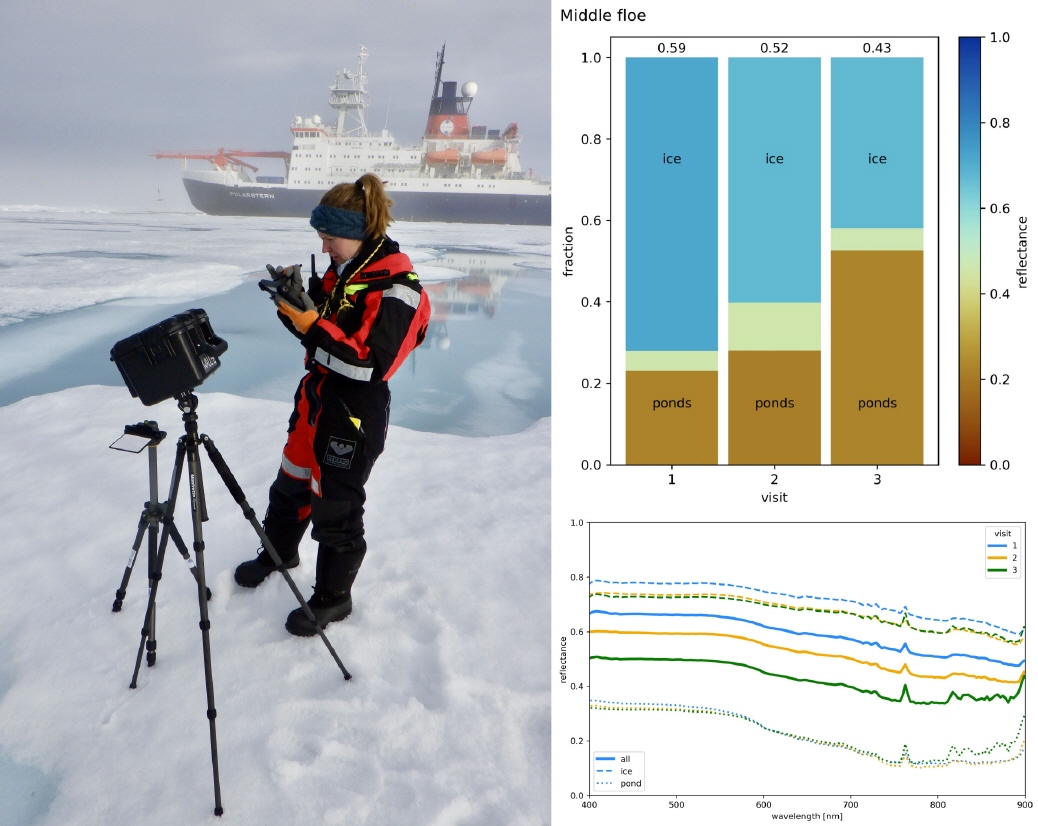
Im arktischen Sommer entstehen Schmelzwassertümpel auf dem Meereis. Sie verringern maßgeblich das Reflexionsvermögen und Albedo der Oberfläche und erhöhen damit die Absorption einfallender Sonnenstrahlung. Dies ist ein selbstverstärkender Prozess und wird auch Eis-Albedo-Rückkopplung genannt. Er spielt eine grundlegende Rolle für die verstärkte Erwärmung der Arktis im Vergleich zu unseren mittleren Breiten.
Die Arbeitsgruppe „Fernerkundung der Polarregionen“ am IUP arbeitet an einem Verfahren, mit dem aus optischen Satellitendaten die Oberflächenalbedo und der von Schmelztümpeln bedeckte Flächenanteil bestimmt werden kann (https://seaice.uni-bremen.de/melt-ponds/). In den letzten zwei Monaten waren wir auf einer FS Polarstern-Expedition in der Arktis unterwegs (https://follow-polarstern.awi.de), um dort neue in-situ Messungen zu sammeln, die jetzt genutzt werden, um das Vorwärtsmodell für die Satellitenbeobachtungen zu verbessern. Mit einer Hyperspektralkamera, WALL-E genannt, wurden spektral hoch aufgelöste Messungen der von Schmelztümpeln und Meereis reflektierten Strahlung durchgeführt, um deren Variabilität und Entwicklung zu untersuchen. Die räumliche Ausdehnung der Messungen ermöglicht zusätzlich eine Einschätzung des Oberflächenanteils der von Schmelztümpeln bedeckt ist. Um die entscheidenden Faktoren für die zeitliche Änderung der Albedo zu ermitteln, wurden die Messungen auf denselben Eisschollen drei Mal zwischen dem 15. und 31. Juli 2022 wiederholt (in der Abbildung „visit“ 1 bis 3). In diesem Zeitraum wurde die Eisscholle „dunkler“ (von 0.59 zu 0.43 Reflexionsgrad), was hauptsächlich auf einen Anstieg der Schmelztümpelbedeckung aber auch eine Verringerung des Reflexionsgrads des Eises zurückzuführen ist (Balkendiagramm oben rechts in der Abbildung).
Kontakt:
Dr. Gunnar Spreen (gunnar.spreen@uni-bremen.de)
Hannah Niehaus (niehaus@uni-bremen.de)
Globale N2O Karten aus GOSAT-2 Satellitendaten
Stickstoffdioxid (N2O), auch als Lachgas bekannt, ist nach Kohlendioxid (CO2) und Methan (CH4) das wichtigste anthropogene Treibhausgas. N2O wird vorwiegend durch natürliche Prozesse (z.B. durch Bakterien) erzeugt, es wird aber auch in der Landwirtschaft (Einsatz von Düngemitteln) sowie bei der Verbrennung von Biomasse freigesetzt. Die Konzentration von N2O in der Atmosphäre ist etwa 1000-mal kleiner als die von CO2, aber das Treibhauspotential von N2O ist fast 300-mal größer, wodurch N2O bedeutsam zum Klimawandel beiträgt.
Es gibt allerdings nur wenige globale Messungen von N2O, speziell durch Satelliten. Die im Bild dargestellte Karte (aus Noël et. al, 2022) zeigt die atmosphärische Verteilung von XN2O (d.h. die mittlere trockene Gesamtsäule von N2O) für April 2019, die am IUP aus Messungen des japanischen GOSAT-2 Satelliten bestimmt wurden.
Wie man darin sieht, sind die Gesamtsäulen von N2O in den Tropen größer als in höheren Breiten. Das liegt daran, dass das meiste N2O in der unteren Atmosphäre, der Troposphäre, erzeugt wird und vorhanden ist und die Troposphäre in den Tropen in größere Höhen reicht.
Referenz:
Noël et al., Retrieval of greenhouse gases from GOSAT and GOSAT-2 using the FOCAL algorithm, Atmos. Meas. Tech. , 15(11), 3401–3437, 2022, doi: rm10.5194/amt-15-3401-2022.
https://amt.copernicus.org/articles/15/3401/2022/
Kontakt:
Stefan Noël (stefan.noel@iup.physik.uni-bremen.de)
Juli 2022:
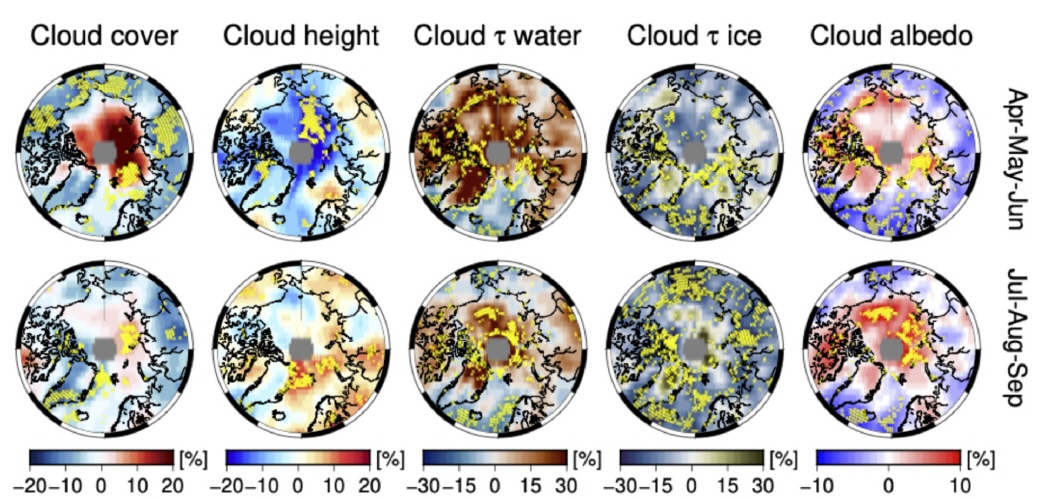
Eine jüngst von der IUP Gruppe „ Cloud Aerosol Surface PArameter Retrieval“ im Rahmen des Transregios (AC)⊃3; durchgeführte Studie untersucht die Wolken, ihre Eigenschaften und die Größe des Strahlungseffektes von Wolken in der Arktis auf der Basis von Satellitendaten.
Arktische Wolken sind ein wichtiger Faktor in der Beeinflussung des arktischen Klimas. Sie wirken dabei sowohl erwärmend als auch abkühlend. Die Gründe wann sie erwärmend oder abkühlend wirken hängen von verschiedenen Bedingungen ab. Hierzu gehören die mikrophysikalischen Eigenschaften der Wolken, die Beleuchtung, die thermodynamische Phase der Wolken (also bis zu welchem Grad sie flüssig oder gefrorenes Wasser beinhalten) und die Reflektivität des Bodens.
Wenngleich bei der Betrachtung über die gesamte Arktis der Bewölkungsgrad sich nicht nennenswert über die Zeit verändert hat, so haben dies einige Wolkeneigenschaften sehr wohl. So z.B. die optische Dicke von Flüssigwasserwolken und der von reinen Eiswolken. Auffällig ist auch teilweise deutliche Veränderung der Wolkenhelligkeit (Cloud albedo).
Reference: The aerosol, cloud and surface property group "Pan-Arctic and regional trends of reflectance, clouds and fluxes: implications for Arctic Amplification" (2022)
Kontakt/contact: Marco Vountas vountas@iup.physik.uni-bremen.de
or Luca Lelli luca@iup.physik.uni-bremen.de
https://www.iup.uni-bremen.de/aerosol
Juni 2022:
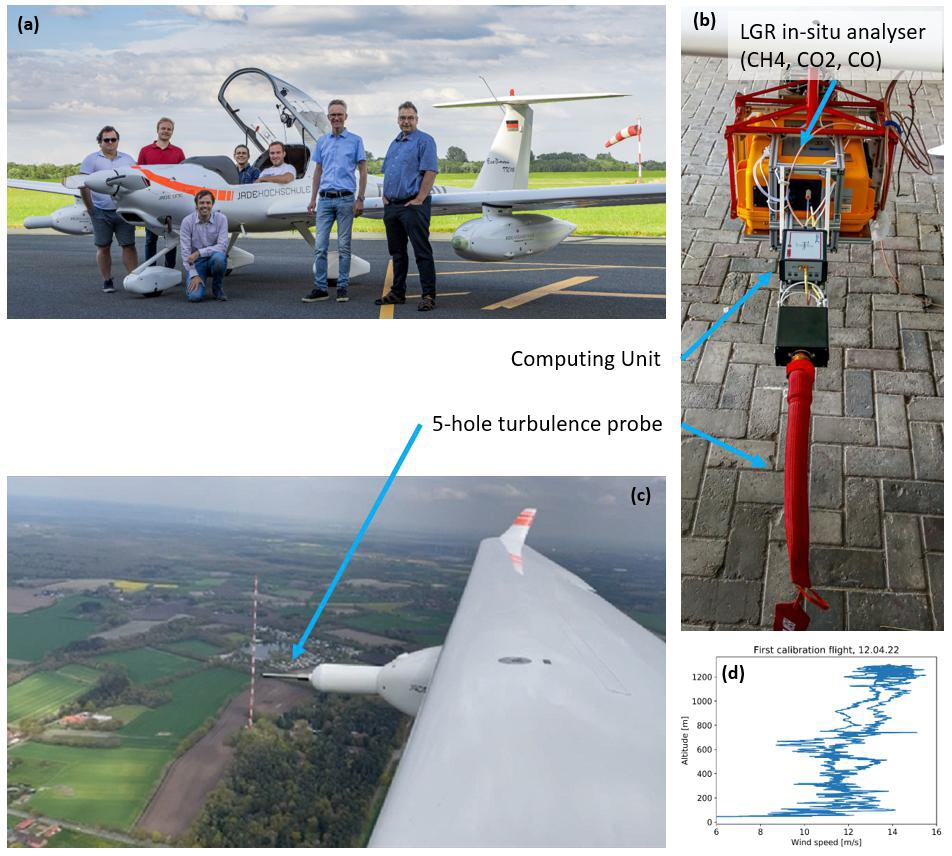
New measurement suite to improve Greenhouse Gases observations from aircraft,
University Bremen, Institute of Environmental Physics
Scientists at the Institute of Environmental Physics are specialised in the development and deployment of various types of airborne sensors to locate and quantify emissions of anthropogenic greenhouse gases by measuring atmospheric Methane (CH4) and Carbon dioxide (CO2) distributions. To accurately estimate emissions from those distributions, precise knowledge of the local wind field is necessary. Therefore, in spring 2022, a newly acquired 5-hole turbulence probe together with a in-situ greenhouse gas analyser, were successfully mounted in one of the wing pods of the motor glider of Jade Hochschule Wilhelmshaven. The Diamond HK36TTC-ECO is a flexible platform for different remote sensing tasks, as it needs no certification process to install sensors. First test flights in cooperation with Jade Hochschule Wilhelmshaven were successfully conducted in northern Germany to calibrate the new instrument. Additionally, fly-bys at the ICOS measurement tower in Steinkimmen/Ganderkesee operated by the German Weather Service DWD, which observes the vertical wind profile at 5 different altitudes till an altitude of 250m, were carried out. Those measurements are used for comparisons and will improve the calibration quality of the wind probe further. Additional, calibration flights comparing measurements from airborne, LIDAR, drone, and tower measurements are planned.
Contact: heinrich.bovensmann@uni-bremen.de
Mai 2022:
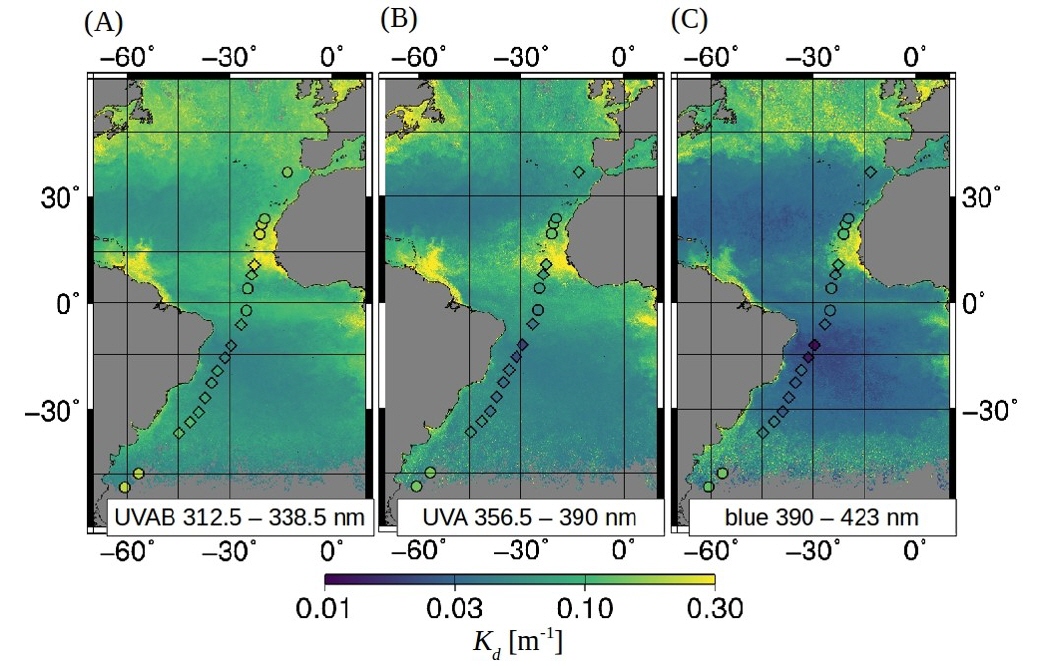
TROPOMI-retrieved underwater light attenuation in three spectral regions in the ultraviolet to blue. Frontiers in Marine Science 9: 787992. doi:10.3389/fmars.2022.787992
Sunlight plays an important role for biological, chemical, and physical processes in the ocean. High-energetic ultraviolet (UV) radiation can have damaging and beneficial effects for aquatic organisms and its interaction with the ocean is generally complex. Most processes feedback with climate warming. Satellite-based observations of light penetration into the ocean in combination with modeling are used to understand these processes and make predictions for the future ocean and climate scenarios in general. Traditional satellite ocean color sensors don’t measure the ultraviolet range. Information on UV light penetration is only inferred indirectly from measurements in the visible wavelength range, naturally connected to lager uncertainties.
This study exploited backscattered UV to blue light data at continuous spectral resolution of 0.5 nm of the TROPOMI sensor onboard the Sentinel-5-Precursor satellite. We present the first direct satellite-based observations of shortwave penetration, in terms of the diffuse attenuation (Kd) into the ocean ranging from the ultraviolet to the blue spectral domain. Our approach is based on Differential Optical Absorption Spectroscopy to retrieve the vibrational Raman scattering (VRS) signal and then combined with coupled ocean-atmosphere radiative transfer modeling (RTM) to derive Kd in the UV range (312.5-338.5 nm and 356.5-390 nm), additionally to the blue Kd (390-423 nm). The VRS signal is well detected in TROPOMI measurements (fit errors <15%) and TROPOMI Kd retrievals exhibit low sensitivity to parametrization of oceanic and atmospheric effects and show good agreement to in situ Kd obtained from in situ measured underwater light spectra.
These products have high potential satisfying user needs in the modeling community which require spectral information on shortwave light penetration for improving estimates of the ocean’s heat budget, primary productivity, photochemical reaction rates of climatically important compounds, and the UV dose rates as an indicator for damaging effects on aquatic organisms.
April 2022:
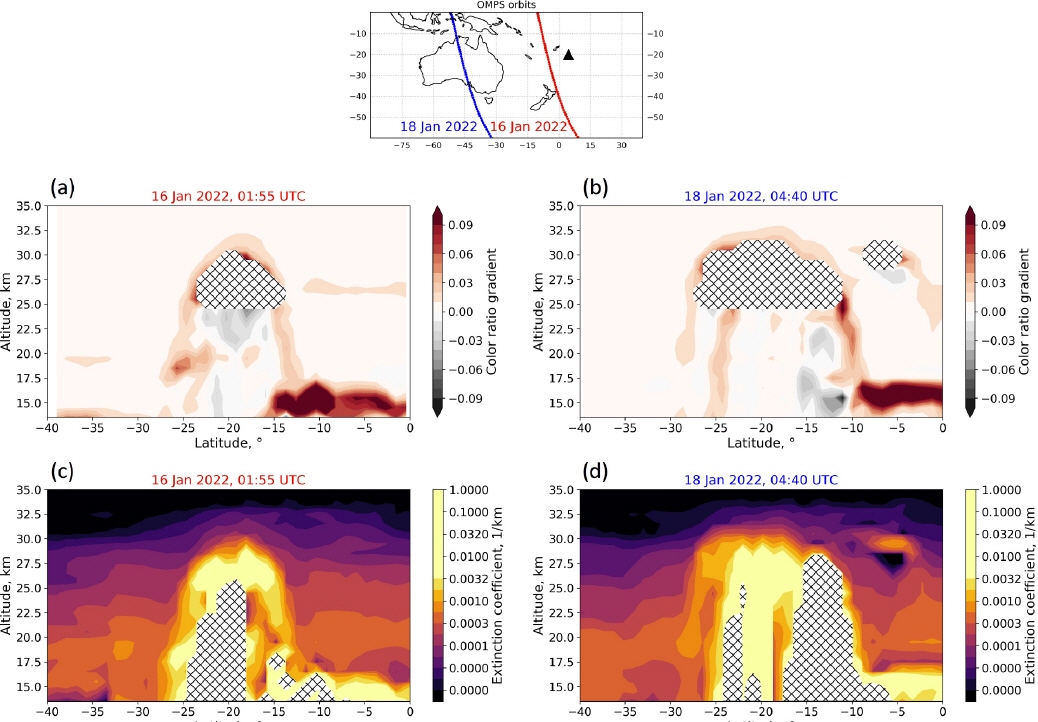
Hunga Tonga-Hunga Ha'apai eruption
On 15th of January 2022, the undervolcano Hunga Tonga-Hunga Ha'apai (20.55°S, 175.40°W), ejected material consisting of gas, steam, and ash up to an altitude of 58 km. This plume height is exceptional and the highest known since satellite observations. Even the second largest volcanic eruption of Mount Pinatubo in the Philippines in 1991 „only“ reached a height of 35 km. Probably, the combination of volcanic heat and superheated moisture from the ocean pushes the aerosols in such unprecedented altitudes.
The uppermost part of the plume sublimated quickly due to the extreme dryness in the mesosphere. In around 30 km altitude, the volcanic plume formed an extensive umbrella carried westward by the strong stratospheric winds. As can be seen from the Figure, this umbrella rose and expanded due to thermal buoyancy and dispersion. It circled the globe within two weeks. The volcanic aerosols will remain in the stratosphere for a long time but have no significant impact on the global climate. The injected aerosol content of 0.4 teragram of sulphur dioxide was too low for that. For comparison: Mount Pinatubo emitted about 18.5 teragram of sulphur dioxide into the stratosphere, temporarily lowering the global temperature by about 0.6°C.
References:
Malinina, E., Rozanov, A., Niemeier, U., Wallis, S., Arosio, C., Wrana, F., Timmreck, C., von Savigny, C., and Burrows, J. P.: Changes in stratospheric aerosol extinction coefficient after the 2018 Ambae eruption as seen by OMPS-LP and MAECHAM5-HAM, Atmos. Chem. Phys., 21, 14871–14891, https://doi.org/10.5194/acp-21-14871-2021, 2021.
https://earthobservatory.nasa.gov
März 2022:
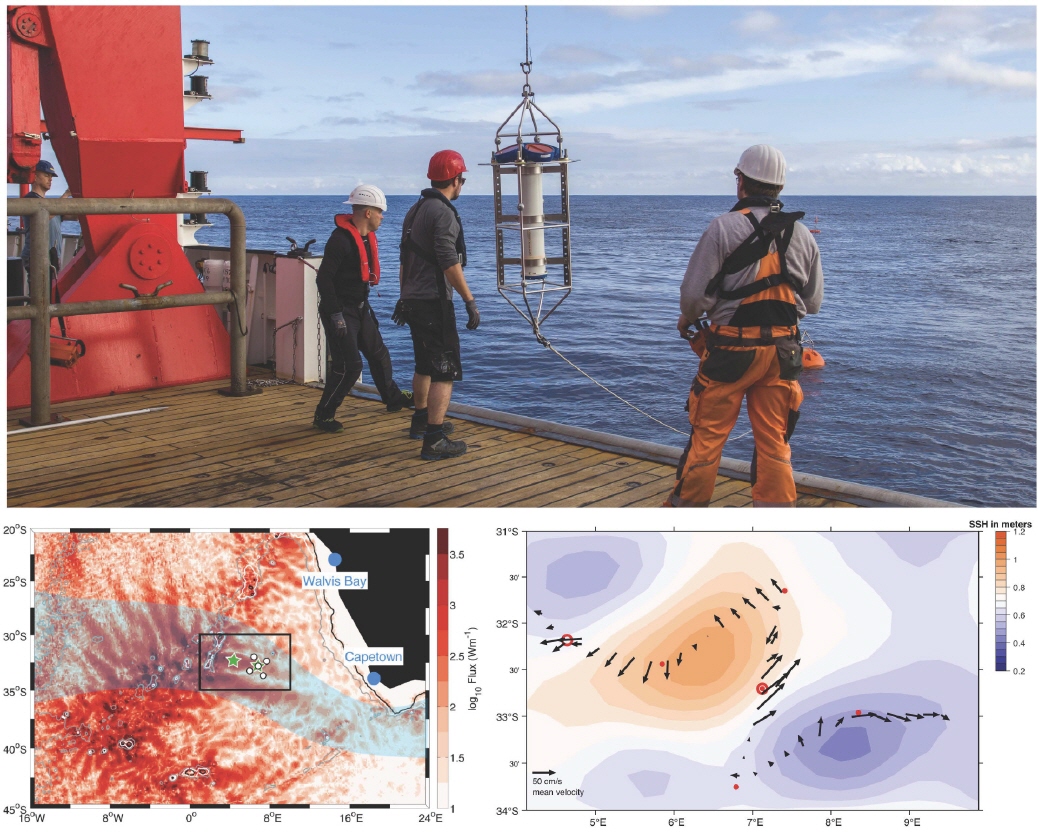
Forschungsfahrt in den Südatlantik
Die Expedition 283 des Forschungsschiffs SONNE, die im Frühjahr 2021 durchgeführt wurde, war etwas Besonderes. Aufgrund der Corona-Pandemie waren viele Forschungsfahrten abgesagt worden, und nun mussten mehrere ozeanographische Verankerungen im Südatlantik geborgen und neue Instrumente eingesetzt werden. Wissenschaftler*innen und Studierende aus vier Instituten begaben sich auf die lange Reise, die aus Gründen des Infektionsschutzes in Emden begann und dort nach 64 Tagen auf See und mehr als 17.000 Seemeilen auch wieder endete. Unsere Gruppe vom IUP setzte zwei tiefe Verankerungen mit Strommessern und Thermistoren sowie 5 Inverted Echo Sounder aus, die Teil des Beobachtungsprogramms des Sonderforschungsbereichs TRR 181 "Energietransfers in Atmosphäre und Ozean" sind (www.trr-energytransfers.de).
Ziel des Experiments ist es, monatelange Zeitreihen von Strömungsgeschwindigkeiten und Temperaturen zu erhalten, um Wechselwirkungen zu untersuchen, zwischen internen Schwerewellen, die vom Walvis-Rücken ausgehen, und Agulhas-Wirbeln, die sich von Südafrika in den Südatlantik ausbreiten. Diese Wechselwirkungen zwischen Wellen und Wirbeln und ihr Austausch von kinetischer Energie sind noch nicht vollständig verstanden. Gezeitenströmungen an Seamounts und Kontinentalabhängen beispielsweise regen interne Schwerewellen an, die Hunderte von Kilometern über Ozeanbecken hinweg wandern können, bevor sie schließlich zur turbulenten Vermischung in der Wassersäule beitragen. Ihr Energieverlust wird durch eine Reihe von Prozessen und Wechselwirkungen bestimmt. In unserem Projekt untersuchen wir die Streuung und Brechung der Gezeitenwellen im Inneren der Ozeane mit dem Ziel, diese Prozesse besser in Klimamodelle zu integrieren.
Februar 2022:
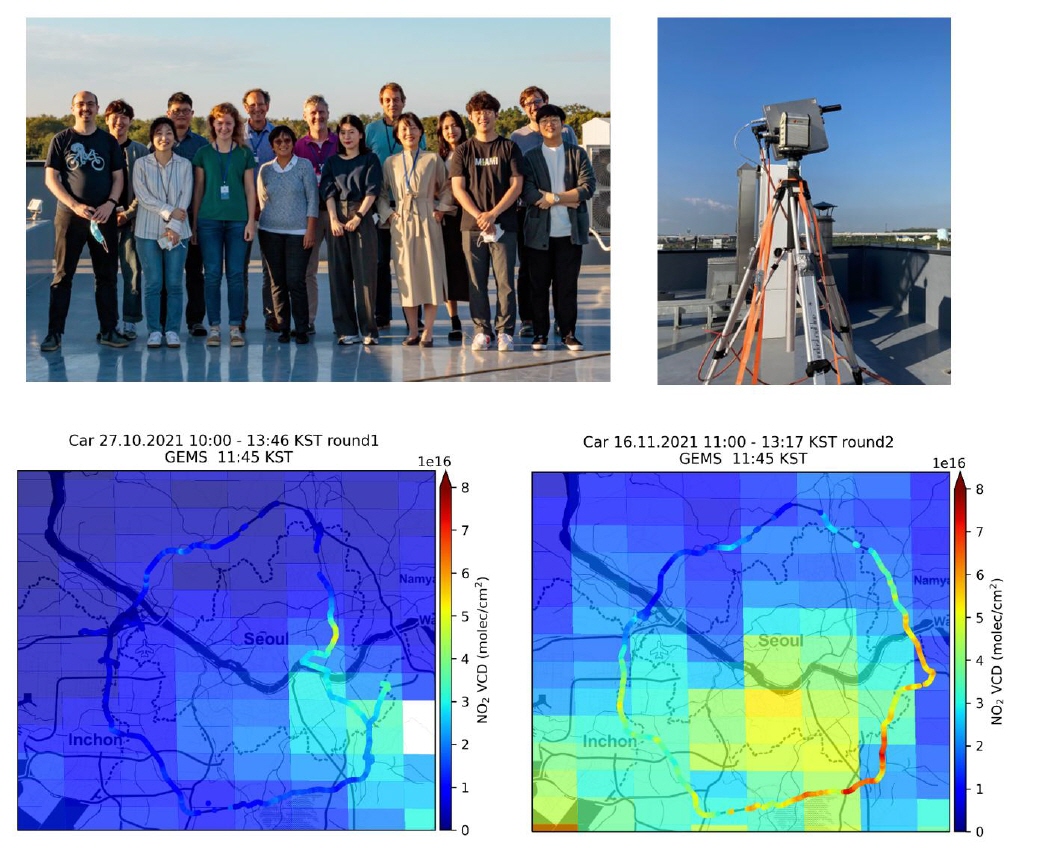
The GMAP-2021 campaign
In October and November 2021, IUP Bremen participated in the GMAP-2021 (GEMS Map of Air Pollution) campaign in South Korea. This campaign brought together instruments from South Korea, the US, Belgium, the Netherlands, and Germany to collect data on air pollution in South Korea for the validation of the GEMS (Geostationary Environment Monitoring Spectrometer) satellite instrument. GEMS is the first geostationary satellite instrument dedicated to air quality, launched by the South Korean space agency in February 2020 and providing measurements of key pollutants over Asia in hourly resolution. Similar instruments will be launched by the US (TEMPO) and Europe (Sentinel-4) in the coming years.
During the GMAP campaign, IUP Bremen installed a multi-azimuth MAX-DOAS instrument on the rooftop of the NIER (National Institute of Environmental Research) building at Incheon. This instrument provides data on the abundance of NO2, HCHO, SO2and other pollutants valuable for long-term validation of GEMS retrievals. It will continue to operate at the location for the coming months. Similar instruments have been deployed by other groups in the Seoul Metropolitan Area and other parts of South Korea, and are expected to help in characterizing and improving the satellite data products.
In addition to the stationary measurements, a large number of mobile DOAS measurements was performed from cars to investigate the spatial variability of NO2, to monitor temporal changes and to estimate NOx emissions from Seoul. The observations show a large variability of NO2within individual GEMS satellite pixels, rapid changes over time and the impact of both, local emissions and transport to the observed NO2column amounts. These data are complemented by both in-situ and remote sensing observations from several aircraft overpasses over the same area.
Further reading:
Jhoon Kim et al., New Era of Air Quality Monitoring from Space: Geostationary Environment Monitoring Spectrometer (GEMS), BAMS, 2020, DOI: https://doi.org/10.1175/BAMS-D-18-0013.1
Januar 2022:
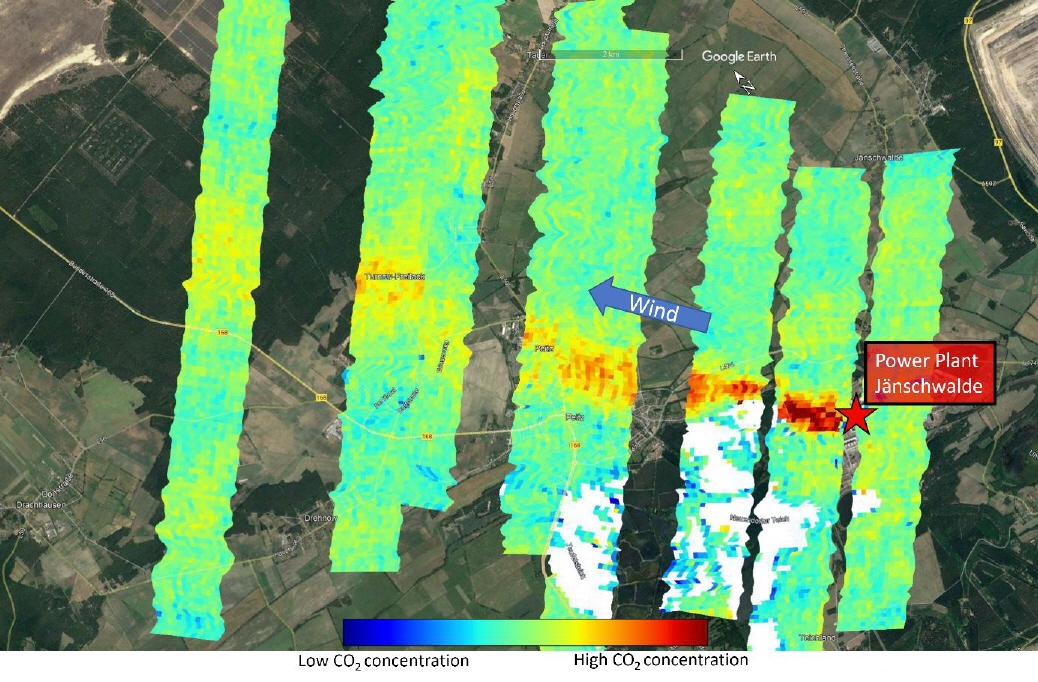
Scientists of the Institute of Environmental Physics are developing new optical sensors to image atmospheric Methane (CH4) and CO2 distributions from aircraft in a similar way as future satellites, but with higher sensitivity to point source emissions. The prototype of the push broom imaging spectrometer – called MAMAP2D-Light – was successfully mounted in the wing pods of the motor glider of Jade Hochschule Wilhelmshaven (see IUP picture of the month June 2021) and successfully performed its first flight over the power plant Jänschwalde near Cottbus, Germany.
Subsequent data analysis resulted in the image shown above, where the CO2 plume of the power plant Jänschwalde is clearly visible in reddish colors. The emissions estimated from this data set matches within its uncertainty range the average emissions during the week of the overflight, and the results and additional performance characteristics have been presented at the fall meeting of the American Geophysical Union in December 2021 (1). In summer 2022 this instrument will be flown onboard the German high altitude research aircraft HALO as part of the international COMET 2.0 campaign targeting high latitude emissions of CH4 and CO2 from wetlands as well as geological seeps and oil/gas production in Canada.
Contact: heinrich.bovensmann@uni-bremen.de
(1) Jakob Borchardt, Konstantin Gerilowski, Sven Krautwurst, Wilke Thomssen, Jan Franke, Martin Kumm, Pascal Janßen, Jens Wellhausen, Heinrich Bovensmann, John P. Burrows(2021), The New Imaging Spectrometer MAMAP2D-Light– Initial Calibration and First Measurement Results, [A25G-1759] presented at 2021 Fall Meeting, AGU, 13-17 Dec., https://agu2021fallmeeting-agu.ipostersessions.com/default.aspx?s=65-03-4F-E7-23-6B-ED-73-35-C6-6C-C5-C7-C1-9E-A9

